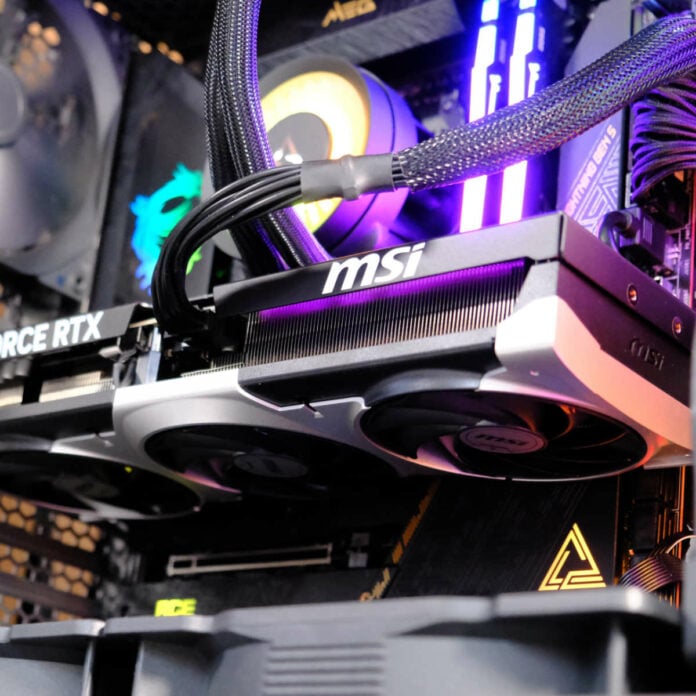Drip-feeding its new graphics cards, Nvidia’s Blackwell duo becomes a trio with GeForce RTX 5070 Ti, bridging the midrange and high-end. With any luck, it’ll be the GPU that defeats the stock woes plaguing both its brethren, but first, it must prove itself worthy in the same trials as RTX 5090 and RTX 5080.
That’s been a tall order in pure rasterisation so far, with the focus firmly on neural rendering trickery instead. Multi Frame Generation (MFG) has divided pixel enthusiasts across the globe, but there’s no denying that it looks a heck of a lot better wrapped in a fetching $749 / £729 package.
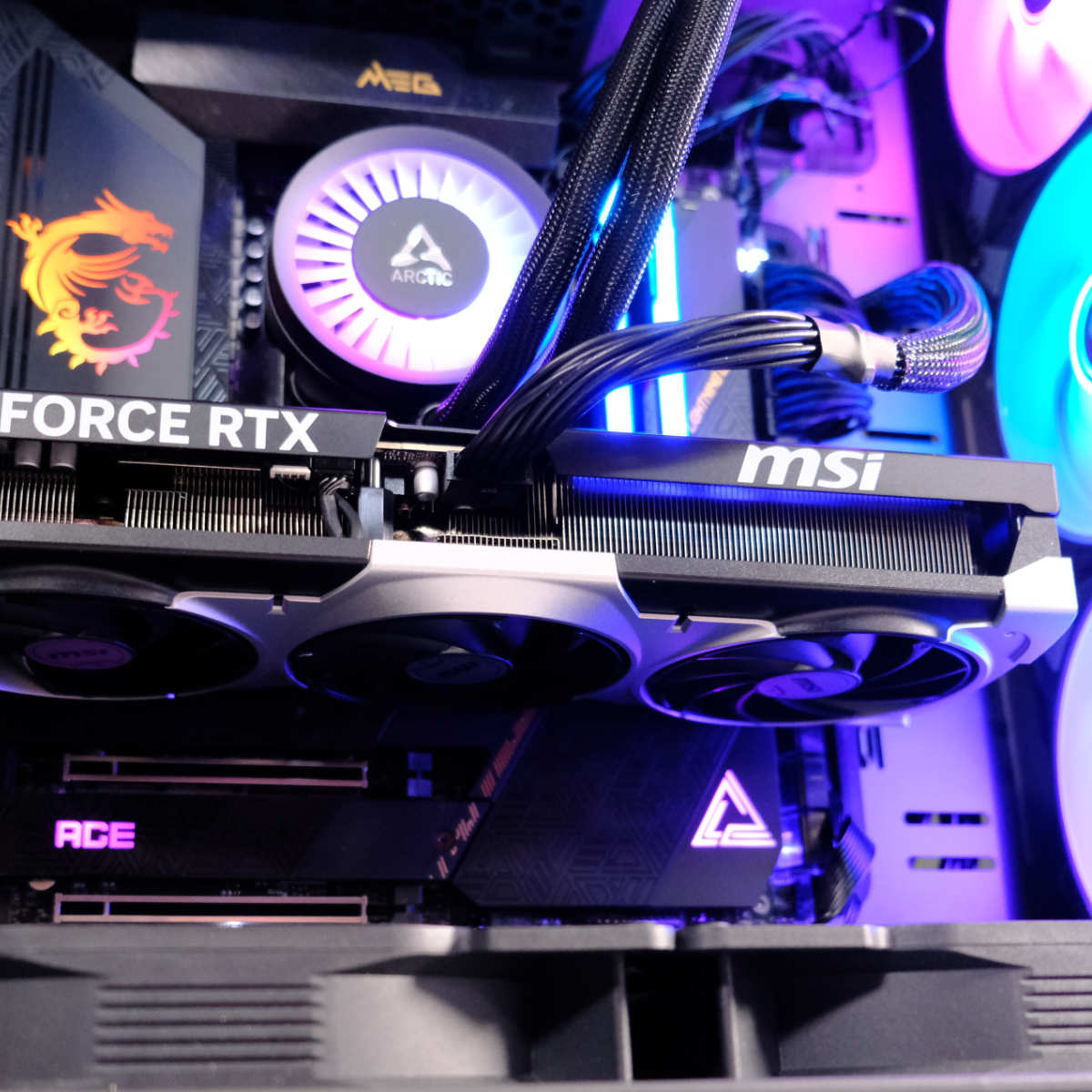

MSI GeForce RTX 5070 Ti Ventus 3X
$749 / £729
Pros
- DLSS 4 is fantastic
- Price is lower than predecessor
- Petite form factor
- GDDR7 memory
- Meaningful Ampere upgrade
Cons
- 16GB of memory sets a lower ceiling
- Incremental rasterised generational uplift
Club386 may earn an affiliate commission when you purchase products through links on our site.
How we test and review products.
There’s a lot to break down, so rather than giving you just one Club386 Table of Doom™, we’re spoiling you with two so you can see exactly where the most affordable GeForce RTX 50 Series GPU thus far fits into the fold.
Specifications
| RTX 5070 Ti | RTX 5080 | RTX 5090 | |
|---|---|---|---|
| Released | Feb 2025 | Jan 2025 | Jan 2025 |
| Codename | Blackwell | Blackwell | Blackwell |
| GPU | GB203 | GB203 | GB202 |
| Process | TSMC 4N | TSMC 4N | TSMC 4N |
| Transistors | 45.6bn | 45.6bn | 92.2bn |
| Die size | 378mm² | 378mm² | 750mm² |
| CUDA cores | 8,960 | 10,752 | 21,760 |
| Boost clock | 2,452MHz | 2,617MHz | 2,407MHz |
| FP32 Boost TFLOPS | 43.9 | 56.3 | 104.8 |
| SM count | 70 of 84 | 84 of 84 | 170 of 192 |
| RT cores | 70 (4th Gen) | 84 (4th Gen) | 170 (4th Gen) |
| RT TFLOPS | 133.2 | 170.6 | 317.5 |
| Tensor cores | 280 (5th Gen) | 336 (5th Gen) | 680 (5th Gen) |
| FP16 Acc TFLOPS | 351.5 | 450.2 | 419 |
| ROPS | 96 | 112 | 176 |
| Memory | 16GB | 16GB | 32GB |
| Memory type | GDDR7 | GDDR7 | GDDR7 |
| Mem. clock | 28Gb/s | 30Gb/s | 28Gb/s |
| Mem. interface | 256-bits | 256-bits | 512-bits |
| Mem. bandwidth | 896GB/s | 960GB/s | 1,792GB/s |
| Board power | 300W | 360W | 575W |
| Launch MSRP | $749 | $999 | $1,999 |
GeForce RTX 5070 Ti shares the stage with RTX 5080, featuring a cut-down GB203 die engineered to meet the more attractive price point. Six of the seven GPCs (Graphics Processing Clusters) remain active, keeping the streaming multiprocessor and ray tracing core counts pretty high.
Seeing the return of 16GB of memory isn’t surprising given the standard set by its big brother, but it feels much more appropriate on a 70-class card than 80. It still brings with it the same bandwidth improvements that come with the new GDDR7 standard, operating at the same 28Gb/s speed as the flagship RTX 5090.
All in all, there are no unexpected cuts here given its 25% lower MSRP. It’s exactly how I envisioned an RTX 5070 Ti would take shape, and Nvidia’s clever positioning leaves ample room for top-end GB202 to be repurposed as an RTX 5080 Ti if and when the need arises.
| RTX 5070 Ti | RTX 4070 Ti Super | RTX 3070 Ti | |
|---|---|---|---|
| Released | Feb 2025 | Jan 2024 | Jun 2021 |
| Codename | Blackwell | Ada Lovelace | Ampere |
| GPU | GB203 | AD103 | GA104 |
| Process | TSMC 4N | TSMC 4N | Samsung 8nm |
| Transistors | 45.6bn | 45.9bn | 17.4bn |
| Die size | 378mm² | 378.6mm² | 392mm² |
| CUDA cores | 8,960 | 8,448 | 6,144 |
| Base clock | 2,300MHz | 2,340MHz | 1,575MHz |
| Boost clock | 2,452MHz | 2,610MHz | 1,770MHz |
| FP32 Boost TFLOPS | 43.9 | 44.1 | 21.7 |
| SM count | 70 | 66 | 48 |
| RT cores | 70 (4th Gen) | 66 (3rd Gen) | 48 (2nd Gen) |
| RT TFLOPS | 133.2 | 102 | 42.5 |
| Tensor cores | 280 (5th Gen) | 264 (4th Gen) | 192 (3rd Gen) |
| FP16 Acc TFLOPS | 351.5 | 320.8 | 174.0 |
| ROPS | 96 | 96 | 96 |
| Memory | 16GB | 16GB | 8GB |
| Memory type | GDDR7 | GDDR6X | GDDR6X |
| Mem. clock | 28Gb/s | 21Gb/s | 19Gb/s |
| Mem. interface | 256-bits | 256-bits | 256-bits |
| Mem. bandwidth | 896GB/s | 672GB/s | 608GB/s |
| Board power | 300W | 285W | 290W |
| Launch MSRP | $749 | $799 | $599 |
Looking across generations towards the graphics cards it replaces, there are no major surprises. Keeping to a tried-and-trusted TSMC 4N fabrication process ensures familiar clock speeds and die size, with an emphasis on newer, better architecture in the form of 4th Gen RT Cores, 5th Gen Tensor Cores, and fast GDDR7 memory.
Power requirements are also largely in line with recent models, allowing for slimmer cards well suited to a wide array of PC chassis, and pricing actually comes down a notch, from $799 for RTX 4070 Ti Super to $749 for RTX 5070 Ti.
As has become tradition for the x70 Ti line, there’s no Founders Edition to speak of, with Nvidia shifting the onus to add-in-board partners. While a great many will sail right past the $749 MSRP with exotic aftermarket coolers, doing so runs the risk of encroaching on RTX 5080 territory. Cards at $749 are best positioned to stave off the imminent Radeon RX 9070 XT threat, and our first example of such comes in the form of MSI’s Ventus 3X.
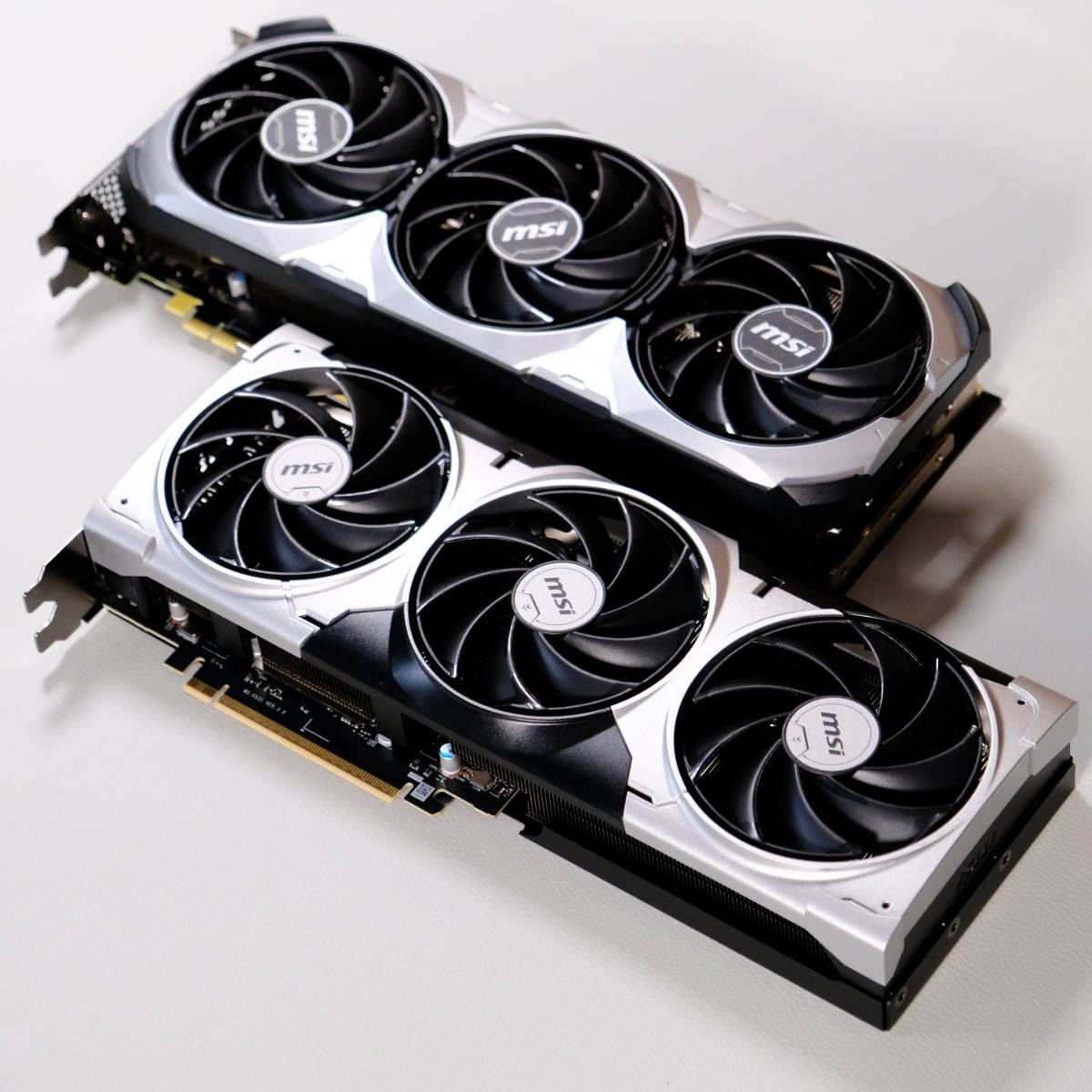
Design
Carrying a long legacy on its shoulders, MSI’s Ventus 3X design will seem vaguely familiar, shunning the bells and whistles of flashier models for an understated two-tone aesthetic. In fact, short of lighter branded stickers, softer edges around the fans, and a black rim, you’d easily confuse it with RTX 4070 Ti Super Ventus 3X.
Alongside pure recognition value, the returning veneer also serves to keep it firmly at its $749 MSRP. This is a mircale in today’s climate as board partners not only continue to skirt tight margins while pleasing Nvidia’s set price, but also not fall prey to inflation that usually comes part and parcel with such high demand.
With the chip on a diet, so too does the cooler slim down to a more forgiving form factor than its high-end alternatives. It almost makes the included support stand a little redundant if it didn’t look so sleek propping up your pixel pusher. Despite trading the hulking chassis for a relatively small shell, it still measures 303mm x 121mm x 49mm with a trio of Torx 5.0 fans keeping things cool. These blowers won’t kick in until the going gets tough, keeping everything silent when idle.
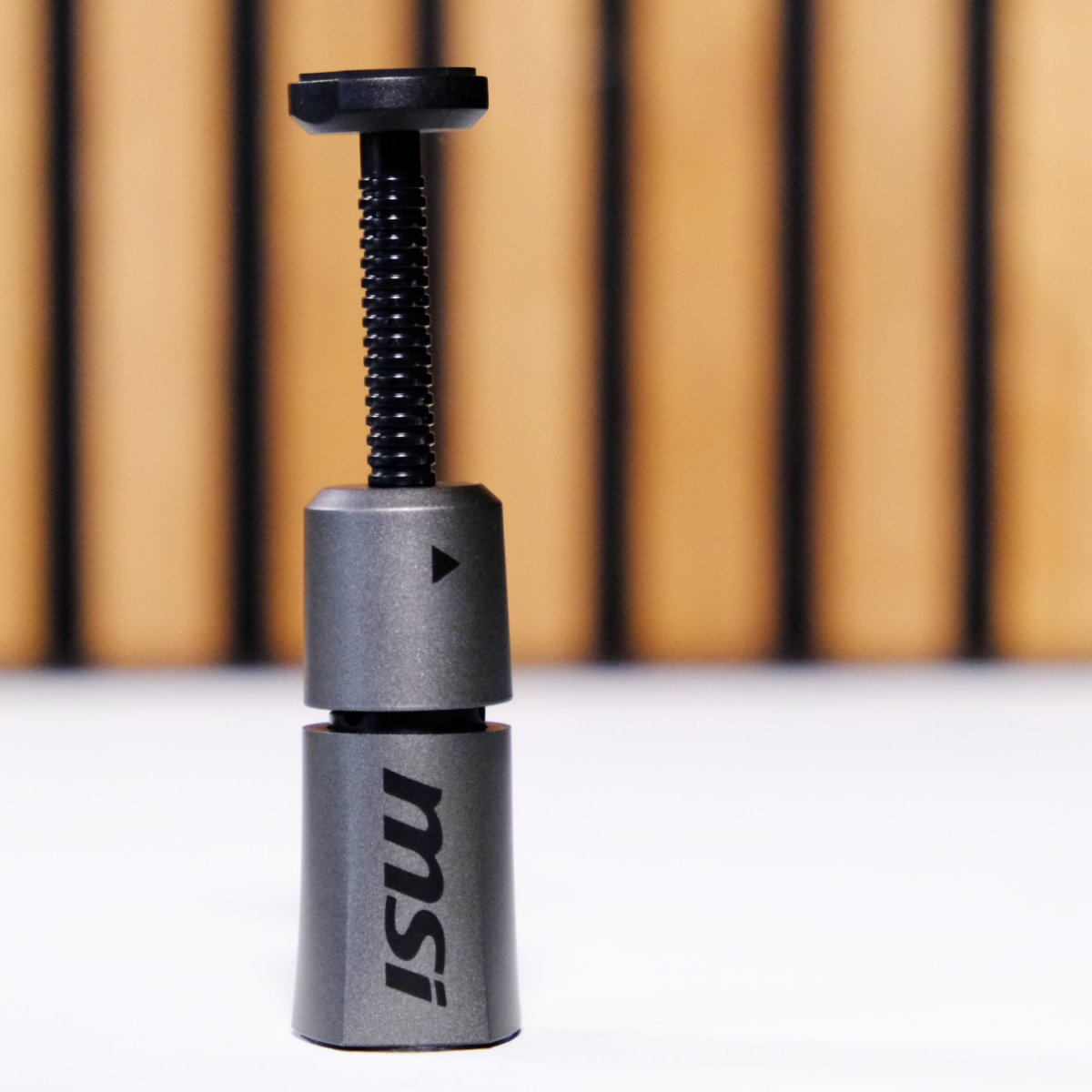
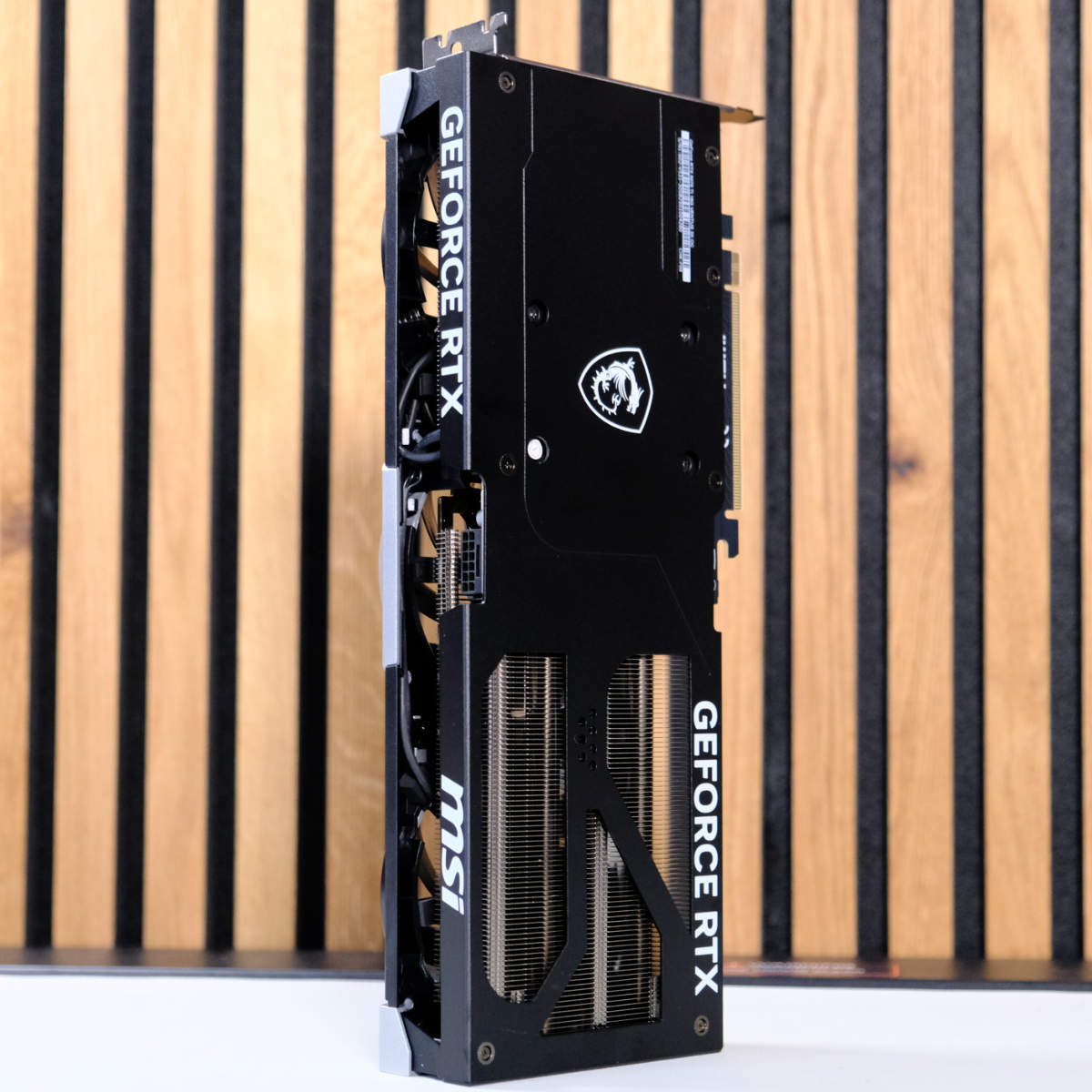
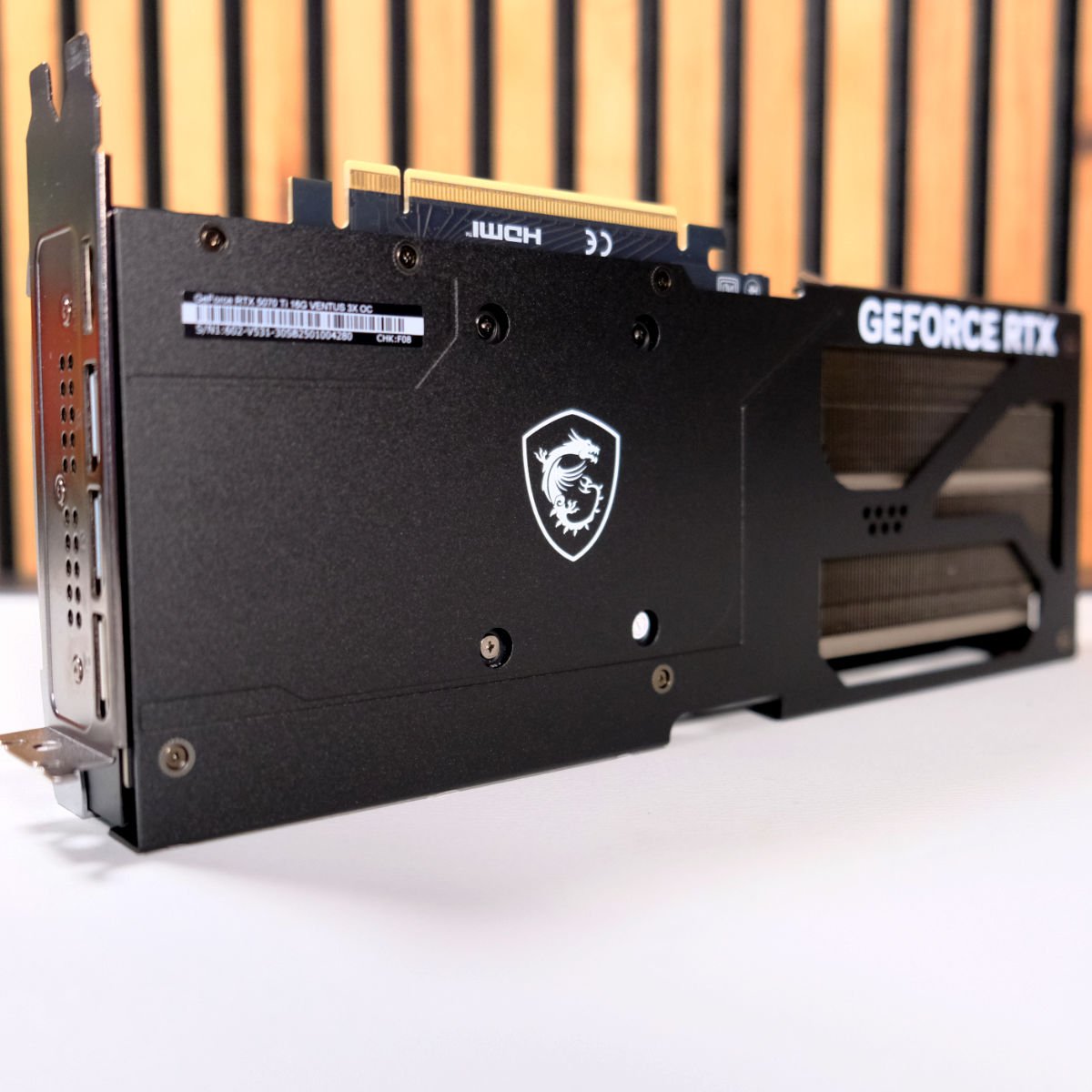
Flip it over and you’ll spot a gorgeous matte black metal backplate brandishing the MSI and GeForce RTX logos. Considering this is what most people will stare at in a horizontal configuration, it gives your setup some class, dressing it to impress all while protecting the core pipes and giving the fin stacks room to breathe.
Even the PCIe connector holds a little surprise. It might look identical to every other contemporary card on the market, but its brand-new Gen 5 interface offers a considerable jump in bandwidth. Early days show some teething issues, but it’s fully backwards compatible and will work just fine with Gen 4 or even Gen 3 motherboards. Just keep in mind that it’s only as fast as the slowest part in the chain.
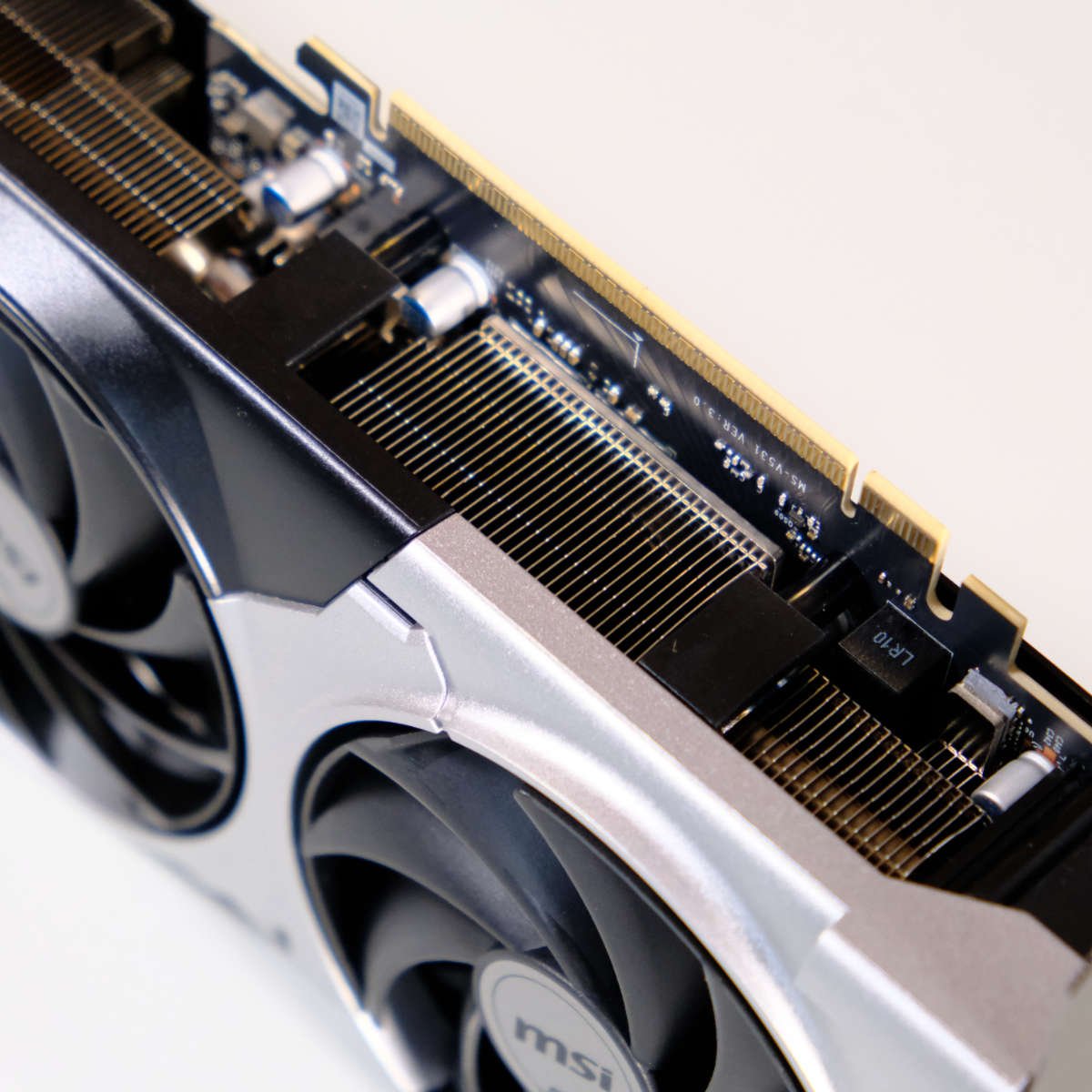
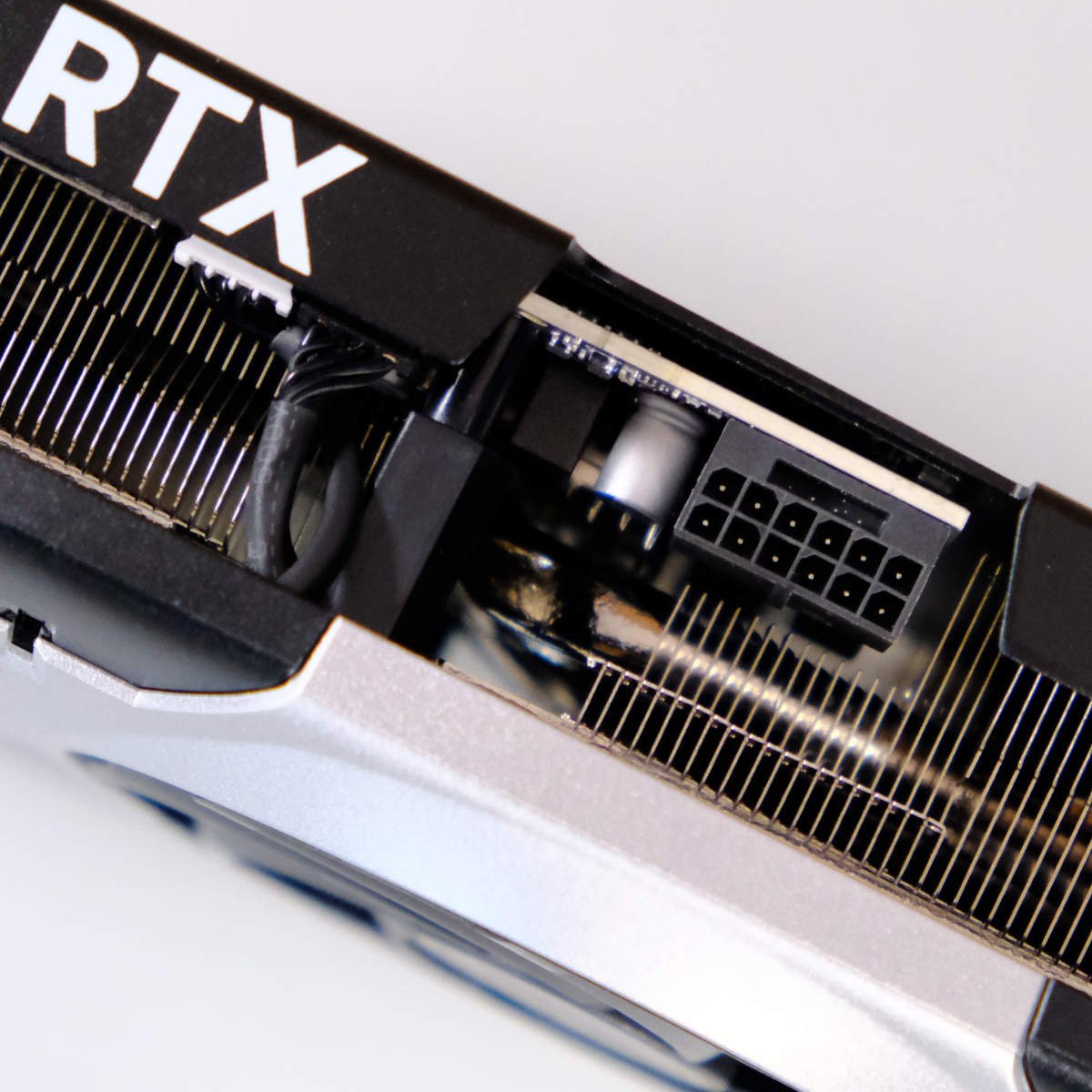
The controversial 12V-2×6 power connector returns from the RTX 40 Series, for better or worse. Although its a revised version of the 12VHPWR port with 0.1mm shorter pins and 0.15mm longer terminals, eyebrows are once again raised with scattered reports of power distribution and melting issues.
Nvidia recommends a 750W power supply to err on the side of caution for its 300W powerhouse, but just like the other RTX 50 Series cards, this seems like an overly cautious estimate. Actual system-wide power draw sits around 432W when under load and 108W when idle in our tests, giving plenty of headroom. Fortunately, MSI takes the pain out of it with a three-year warranty just in case anything does go wrong.
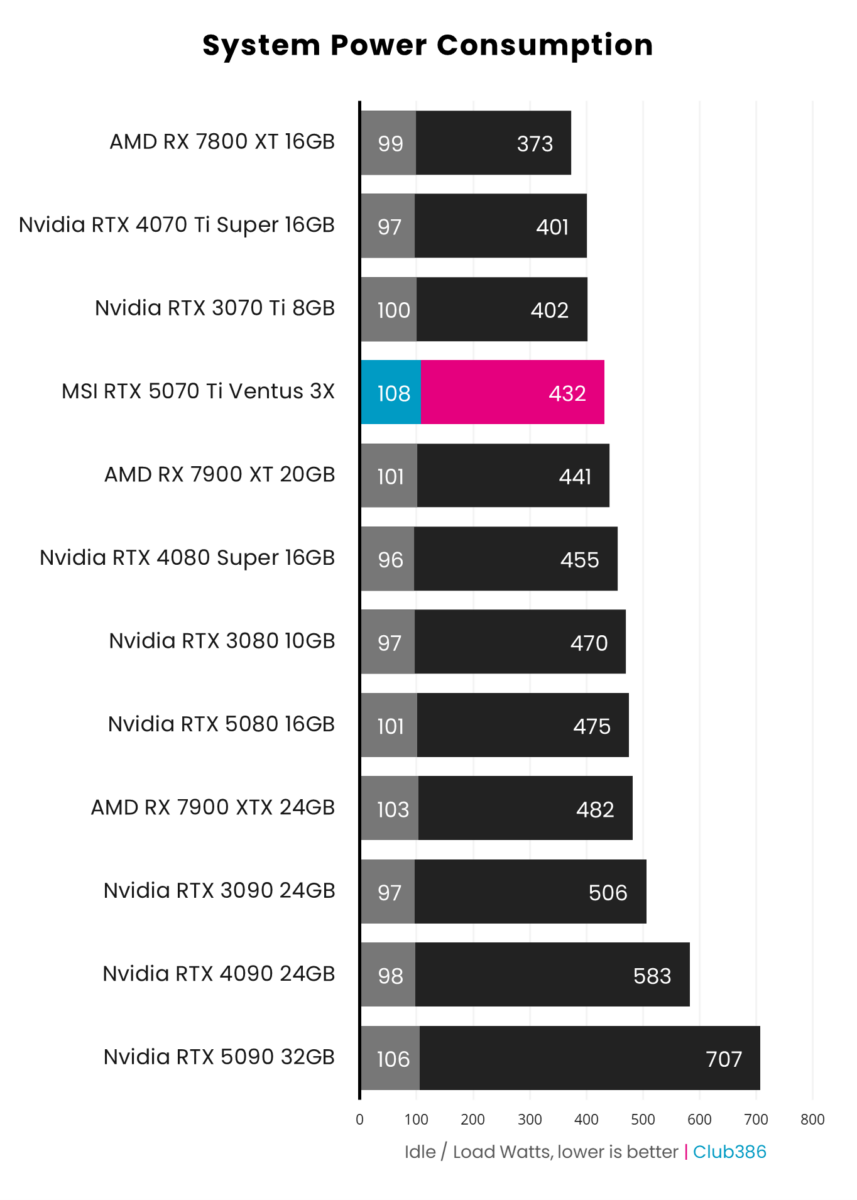
While you might be better served with a power supply outfitted with a 12V-2×6 port to use a single cable, MSI supplies you with a two-way eight-pin splitter for any modern PSU. It doesn’t contain colour-coded headers like MSI’s more premium counterparts, so you’ll want to double check you’ve seated it right before switching on.
Soft power demands lead to better peak temperatures, with the buck stopping at a chilled 65°C. Such cool runnings mean there’s no pressing need for MSI to raise fan speed quite so high. The card routinely peaks at over 2,000rpm, registering 43.6dB on my trusty sound meter, making it a tad noisier than need be. I’d be inclined to soften the fan curve; there’s ample temperature headroom to do so.
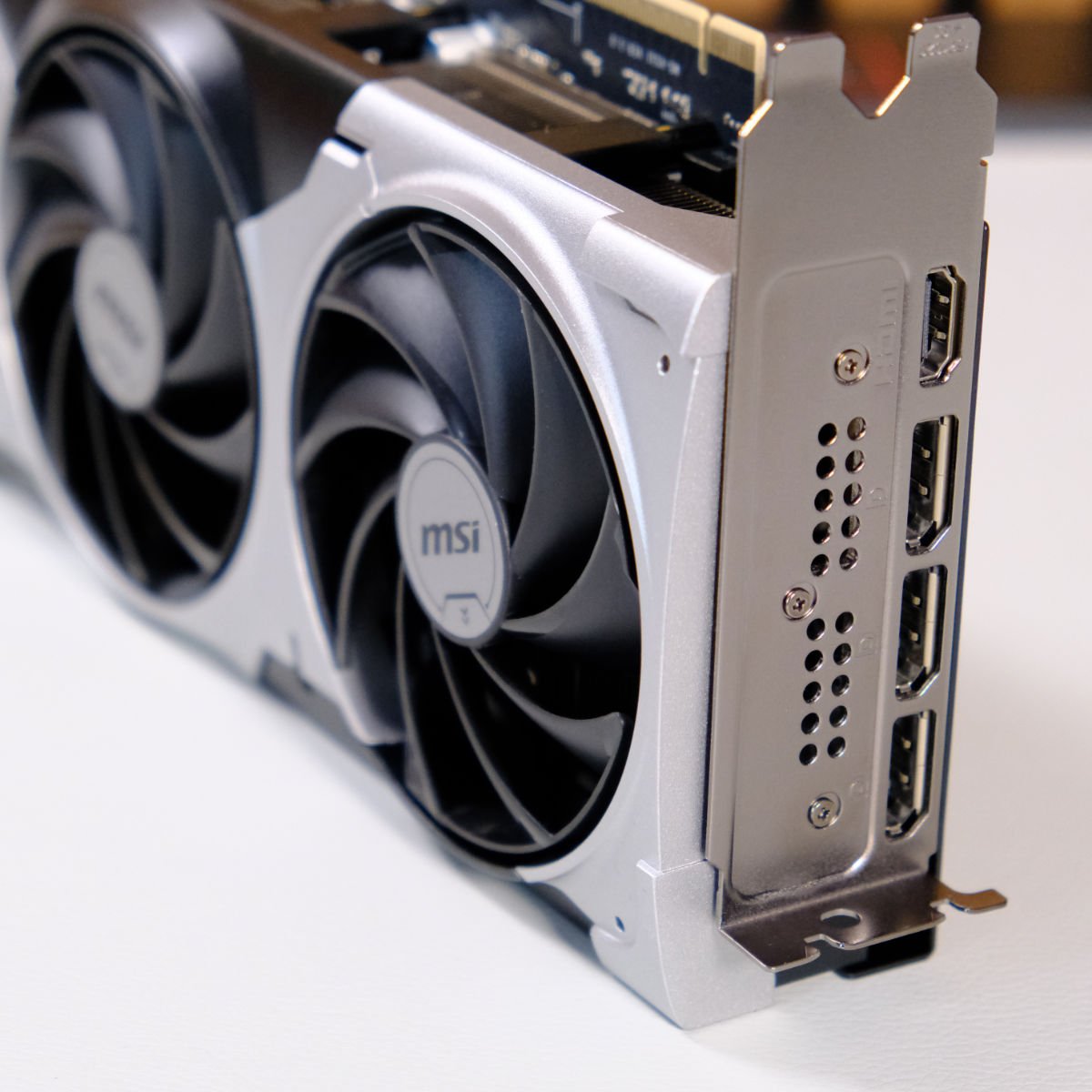

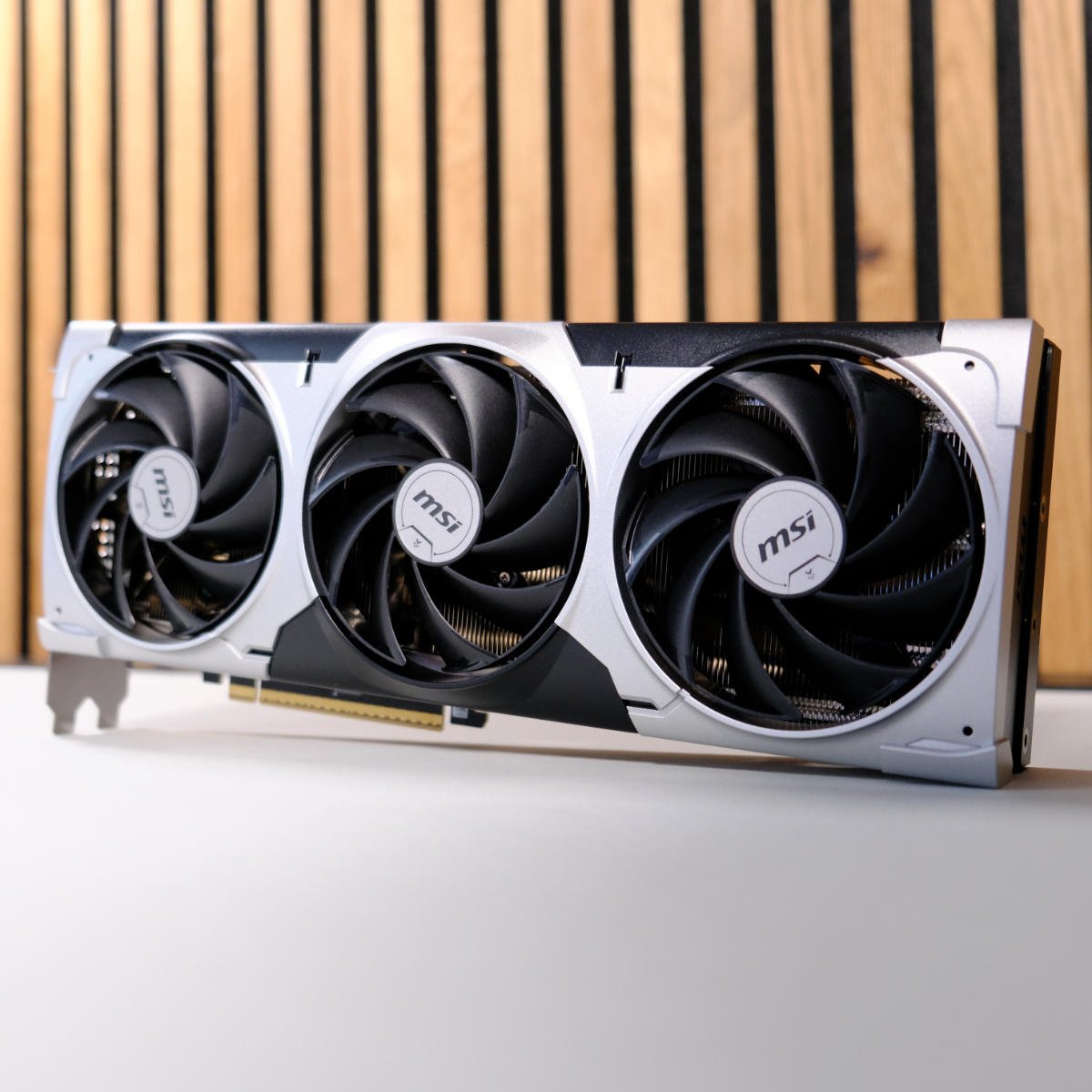
Like all RTX 50 Series models, you get your pick of the latest display outputs. There are three DisplayPort 2.1b and a single HDMI 2.1b, all of which pack enough bandwidth to handle 4K 12-bit HDR at 480Hz or 8K 12-bit HDR at 165Hz alongside display stream compression (DSC). You’ll struggle to hit those ceilings with RTX 5070 Ti’s performance, but it’s a neat example of better to have and not need than need and not have.
Performance
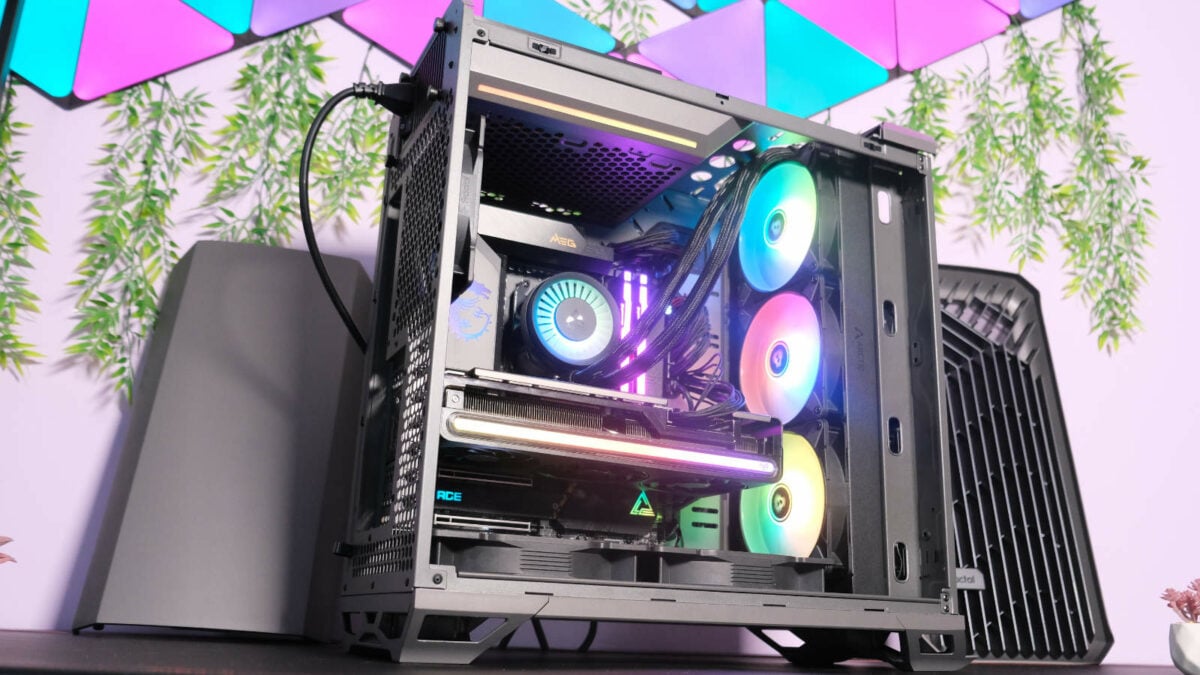
Our 7950X3D Test PCs
Club386 carefully chooses each component in a test bench to best suit the review at hand. When you view our benchmarks, you’re not just getting an opinion, but the results of rigorous testing carried out using hardware we trust.
Shop Club386 test platform components:
CPU: AMD Ryzen 9 7950X3D
Motherboard: MSI MEG X670E ACE
Cooler: Arctic Liquid Freezer III 420 A-RGB
GPU: Sapphire Nitro+ Radeon RX 7800 XT
Memory: 64GB Kingston Fury Beast DDR5
Storage: 2TB WD_Black SN850X NVMe SSD
PSU: be quiet! Dark Power Pro 13 1,300W
Chassis: Fractal Design Torrent Grey
Being the third Blackwell graphics card to march through our labs, it’s sat in the same Ryzen 9 7950X3D-led Club386 test bench as RTX 5080 and RTX 5090 before it. This pairs it with some of the best hardware on the market, seeing what it’s truly capable of.
Application & AI
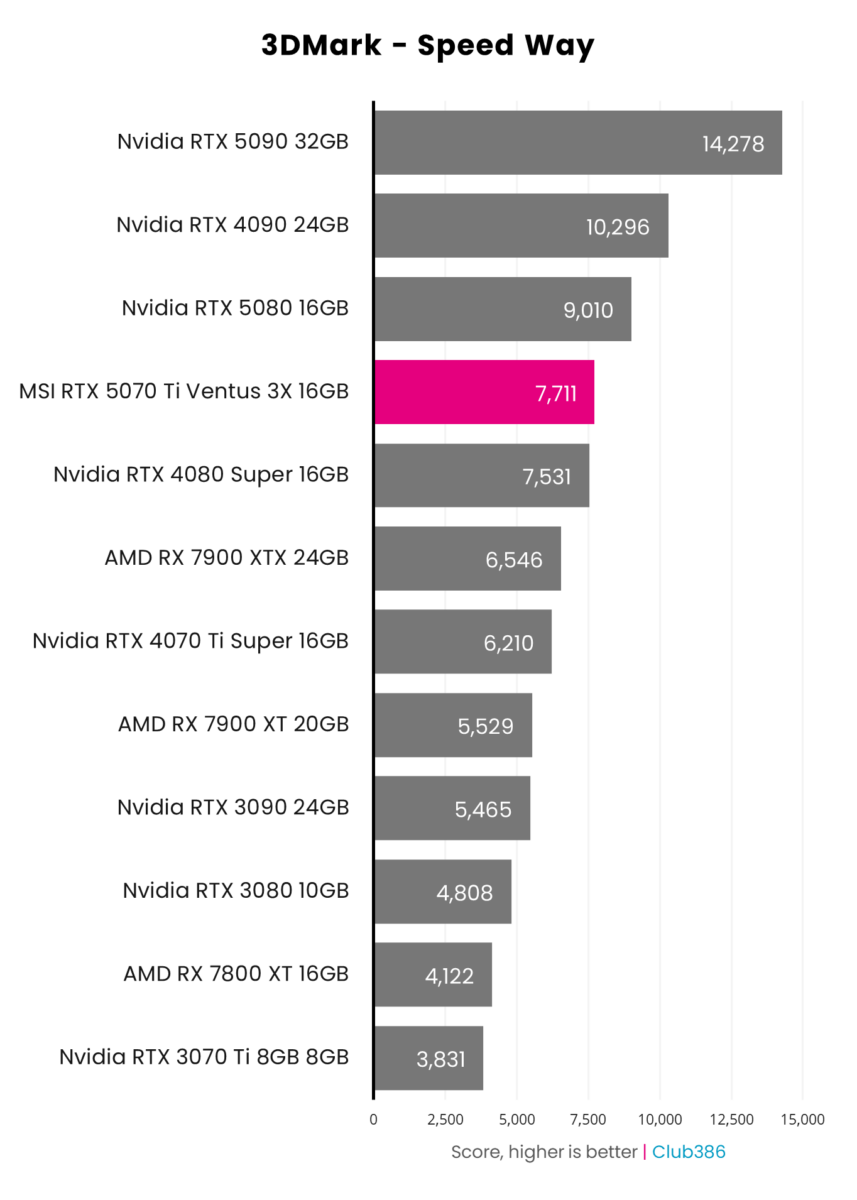
Kicking things off strong, MSI GeForce RTX 5070 Ti Ventus 3X eclipses its Super predecessor by 24% in 3DMark Speed Way tests, showcasing its ray tracing prowess. In a surprising turn of events, it also seamlessly slips past RTX 4080 Super in the process.
I’m pleasantly surprised with its relative performance to the big, bad RTX 5090. While it’s just 46% of the flagship, it sits 63% cheaper, underscoring RTX 5070 Ti’s mass-market appeal.
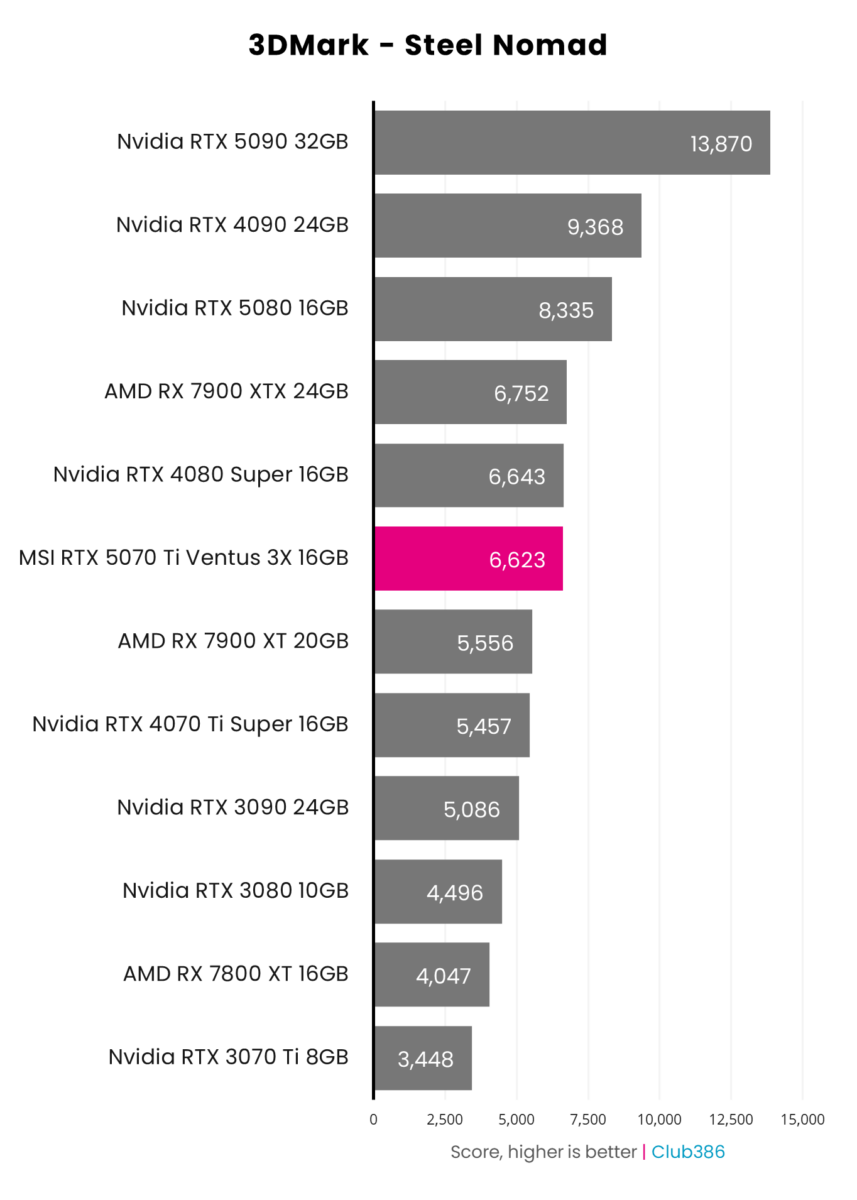
The tussle continues in 3DMark Steel Nomad, with RTX 5070 Ti slipping slightly behind RTX 4080 Super in rasterised efforts. That said, it comfortably offers a gen-on-gen performance uplift of up to 21%.
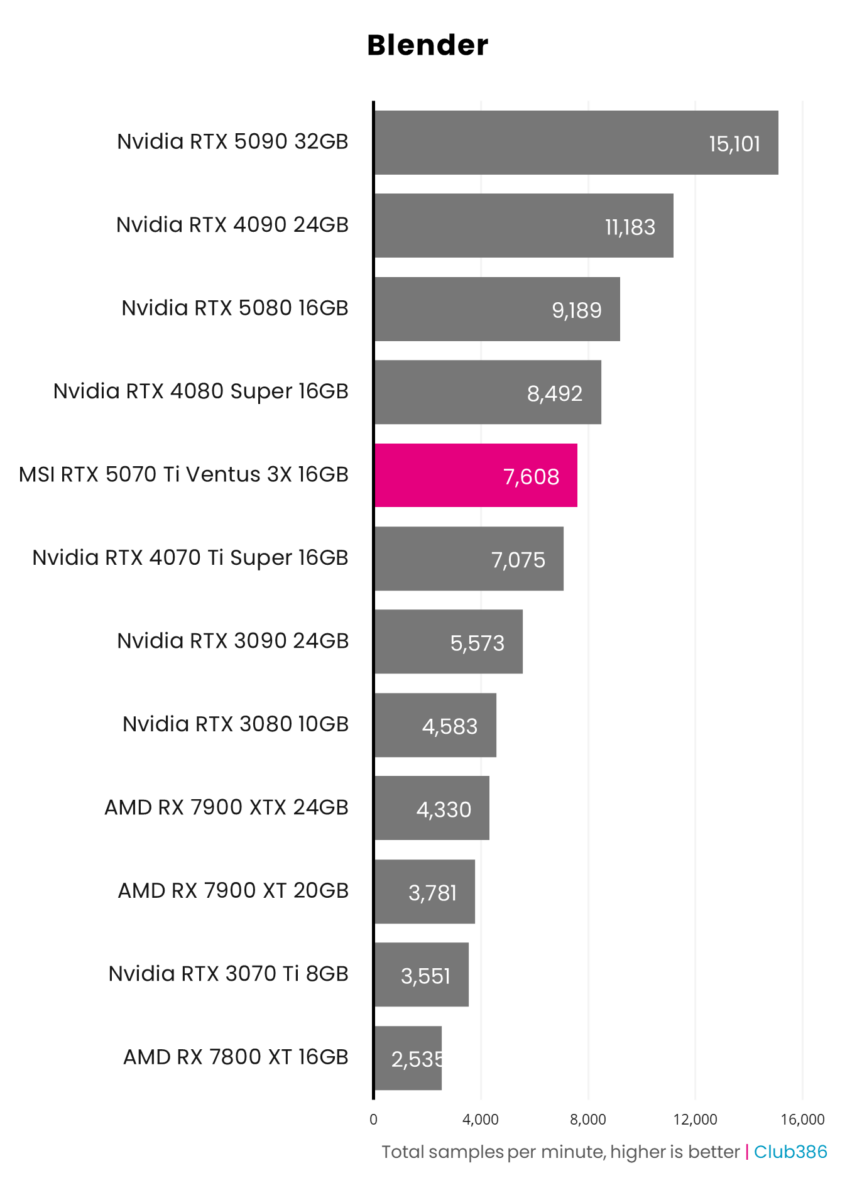
The pattern continues in Blender, as RTX 5070 Ti is sandwiched between its Super predecessors. It’s a solid card for content creators, but admittedly only outshines RTX 4070 Ti Super by less than 8%.
Anyone leaping from RTX 30 Series will find it a much more compelling upgrade, seeing a 37% jump from the Ampere flagship to more than double RTX 3070 Ti.
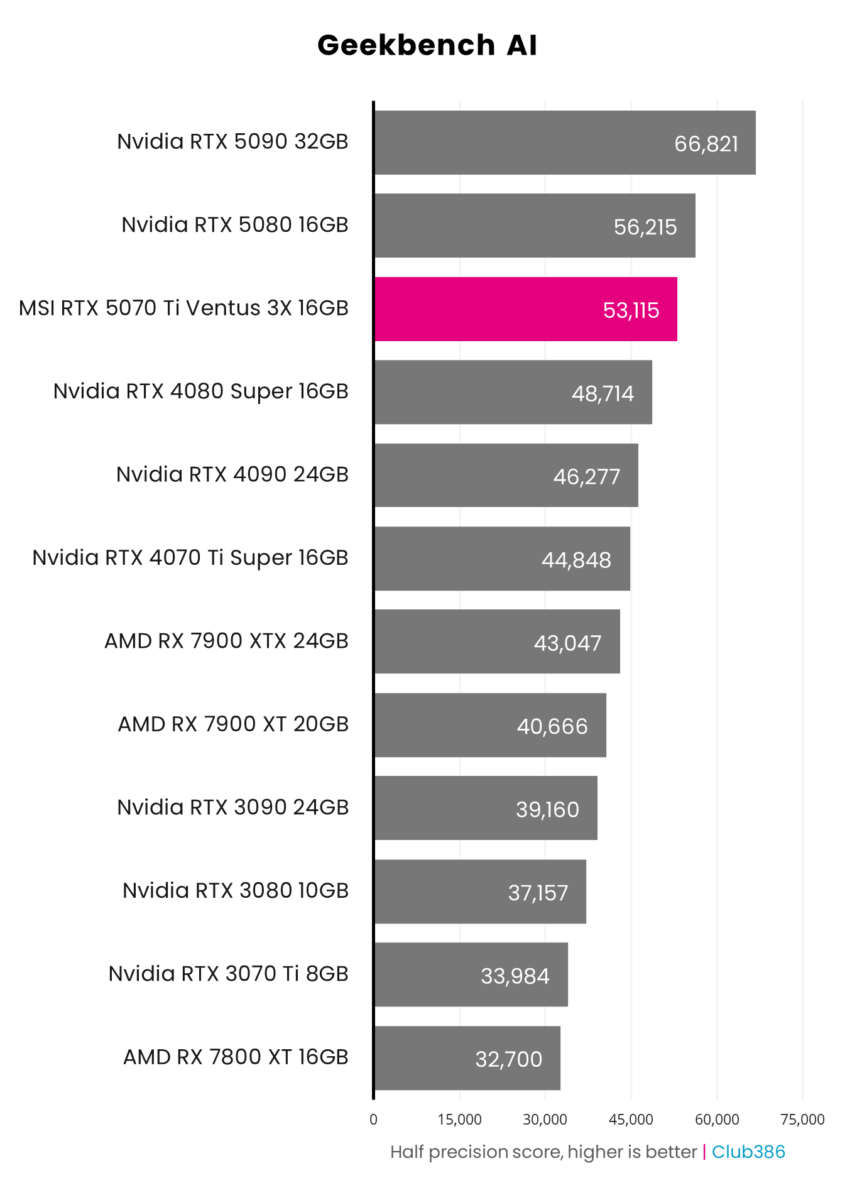
Blackwell has proven an AI darling so far, and MSI GeForce RTX 5070 Ti Ventus 3X is no exception. It takes the bronze medal leaving AMD in the dust, third to only its bigger brothers.
Much of its impressive 53,115 half-precision Geekbench AI score comes from the improvements 5th Generation Tensor Cores bring with them, keeping even RTX 4080 Super and RTX 4090 at arm’s length.
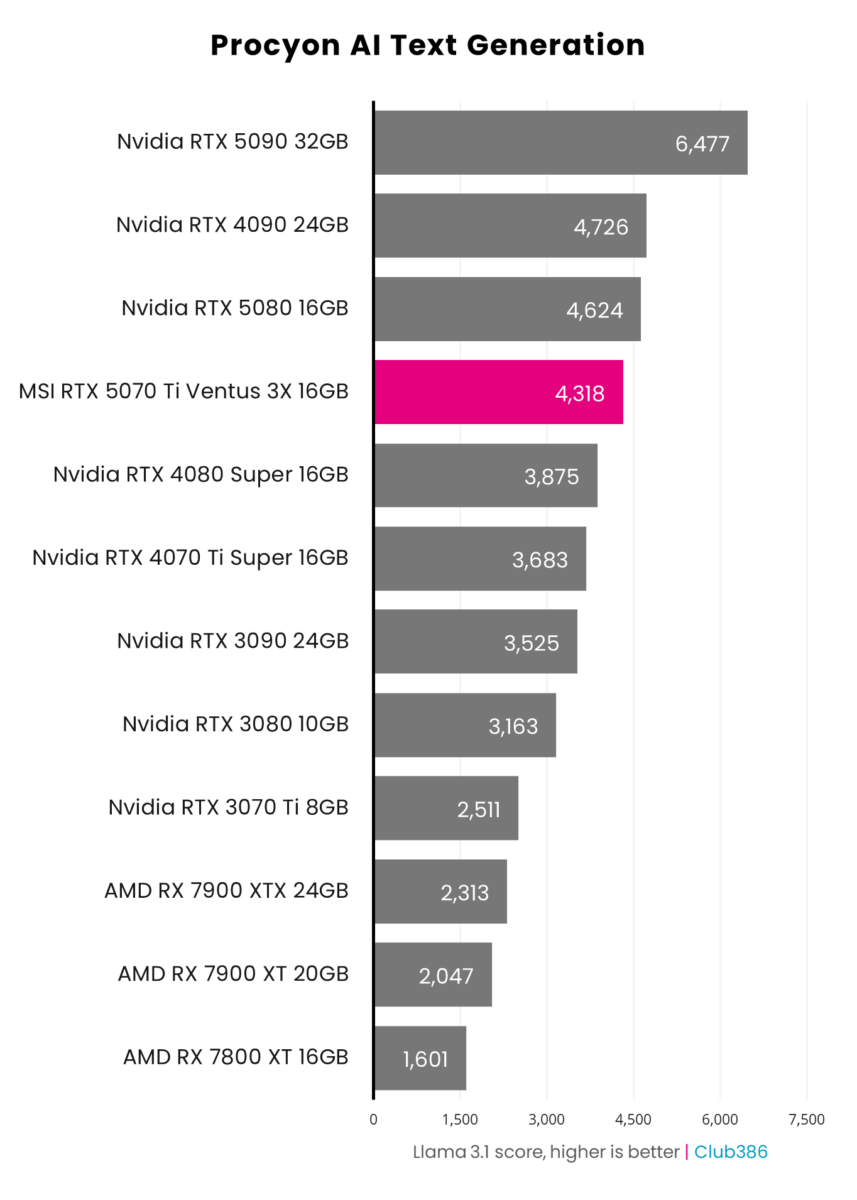
It’s a similar story in Procyon AI Text Generation. Using the Llama 3.1 model as a framework, few graphics cards come close to Blackwell’s brawn in large language models, with the Ada Lovelace champion proving the only exception.
MSI GeForce RTX 5070 Ti Ventus 3X scores an admirable 4,318, affording it an 11% lead over RTX 4080 Super and 17% over RTX 4070 Ti Super. Meanwhile, Nvidia Ampere and AMD graphics cards barely play in the same ballpark, with the closest competitor slipping 23% behind.
But really, you want to know about games, right?
Game Rasterisation
As always, synthetic tests are but half the battle, particularly for a graphics card squarely aimed at midrange gamers. We’ve chosen a selection of triple A titles to showcase where the newcomer sits compared to its rivals, using the most popular 1920×1080 (FHD), 2560×1440 (QHD) and 3840×2160 (UHD) resolutions.
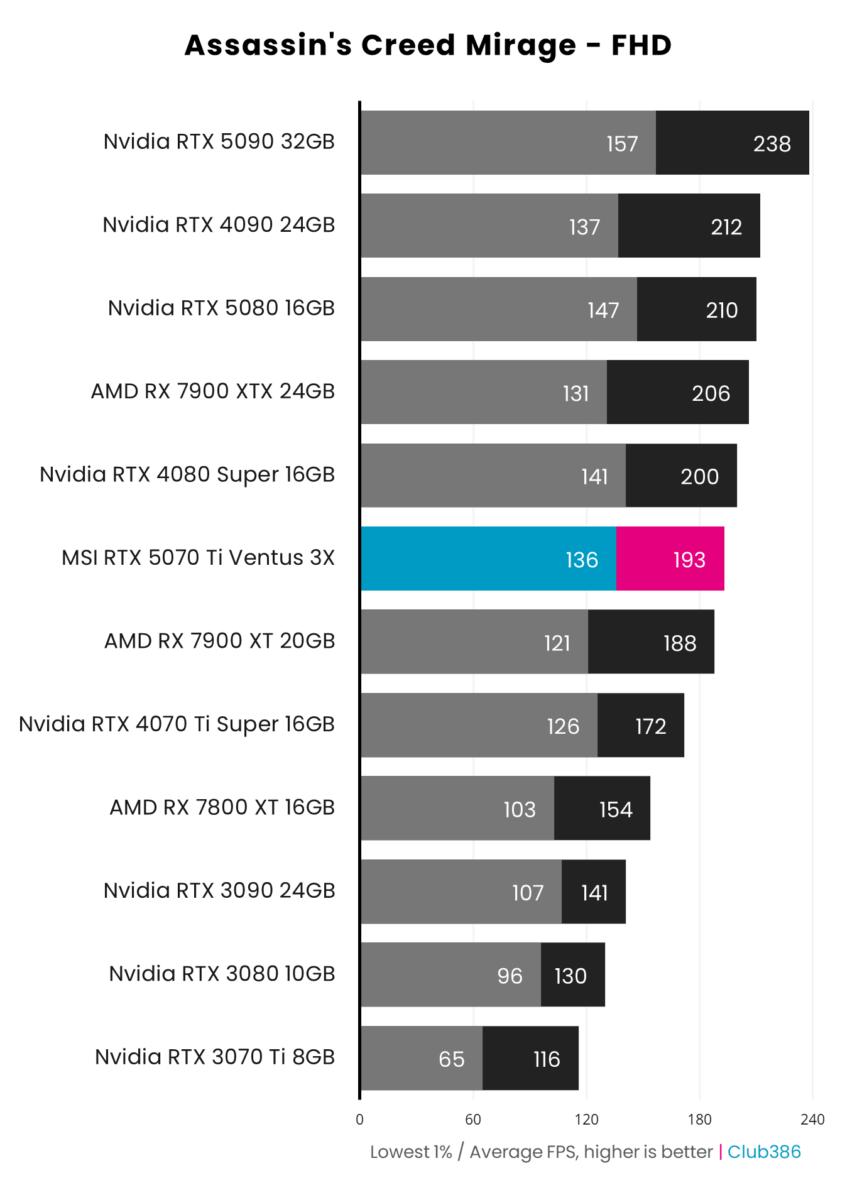
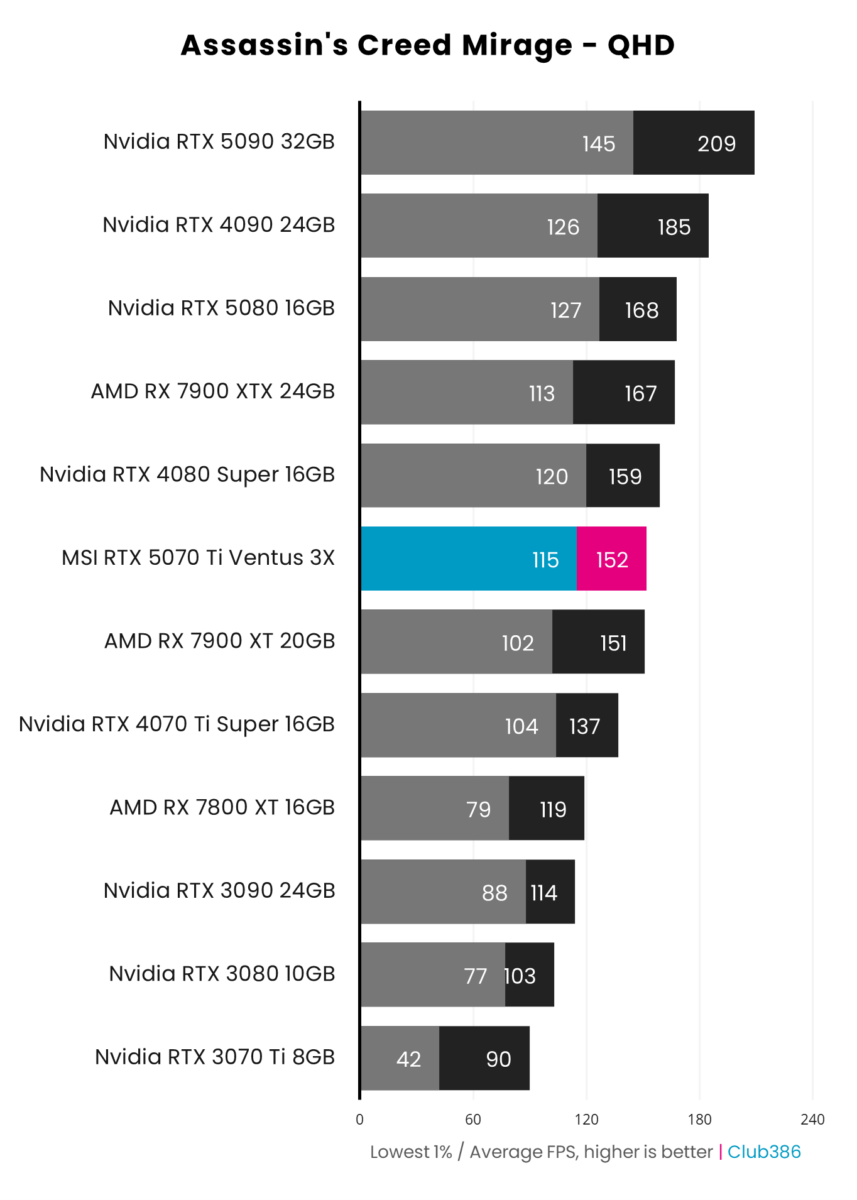
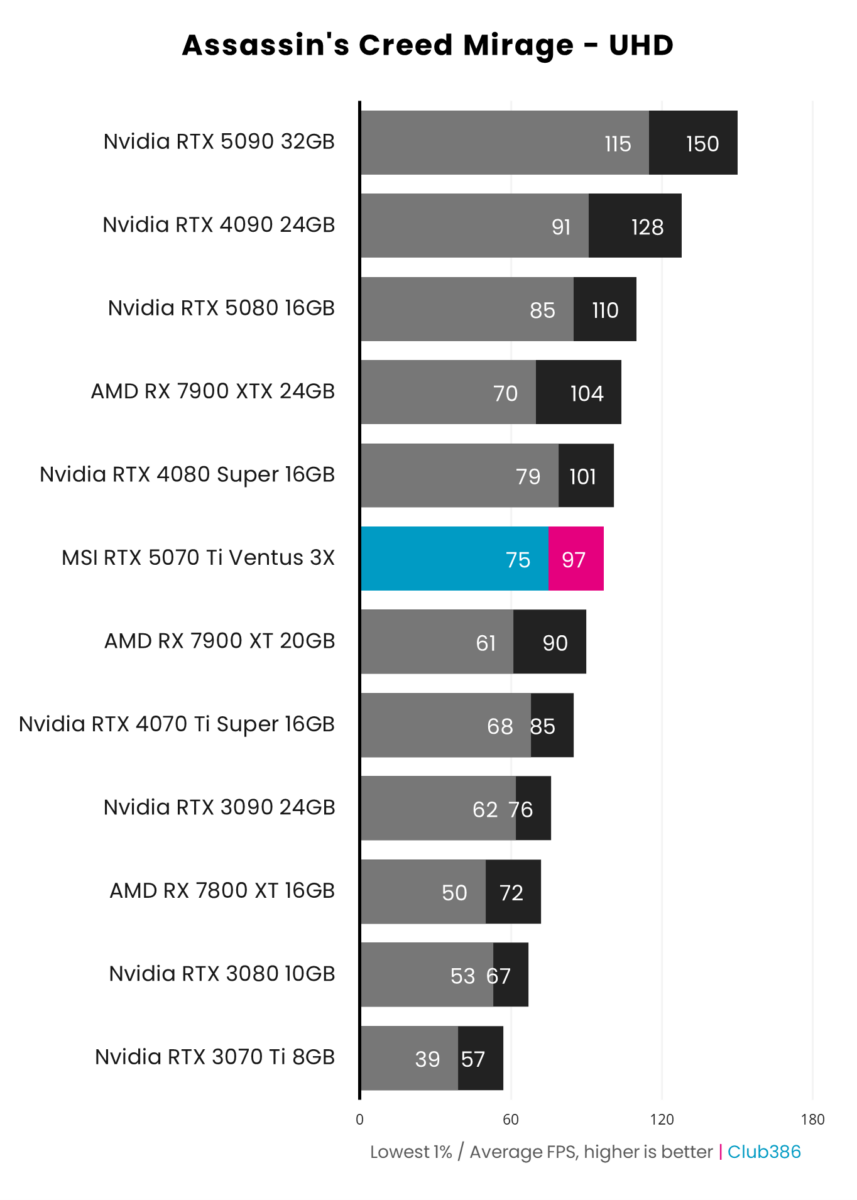
Mirroring its 3DMark performance, RTX 5070 Ti is right on RTX 4080 Super’s tail in Assassin’s Creed Mirage, leaving no more than 7fps in it at any resolution. It also puts up to a 14% gap between it and its predecessor, with the biggest distance coming from UHD.
It’s a clear winner in the QHD arena, sitting within 10% of RTX 5080 while being 25% cheaper. Its real competition actually comes from AMD Radeon RX 7900 XTX, which currently sits at $899 thanks to a couple of years’ worth of discounts. This is a title in which Radeons historically play well, so we’re intrigued to see how next-gen AMD cards fare in just a couple of weeks’ time.
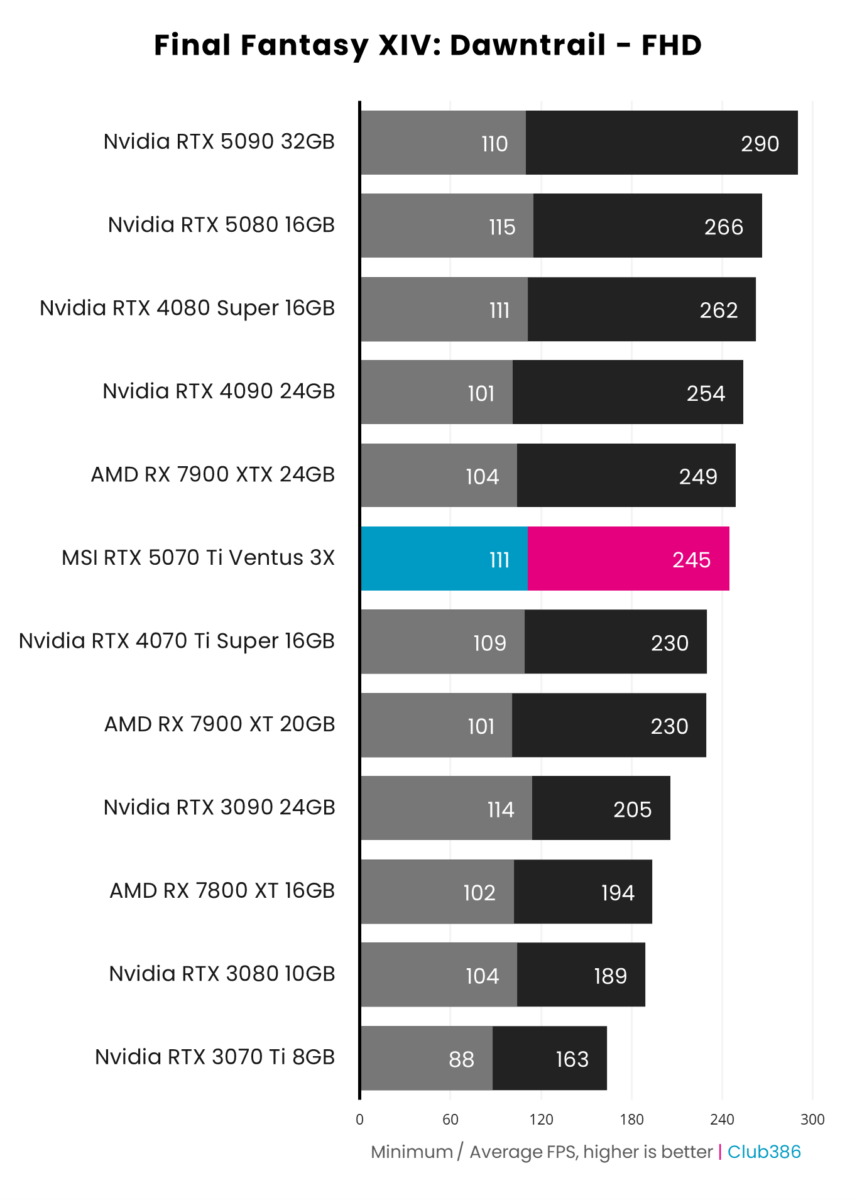
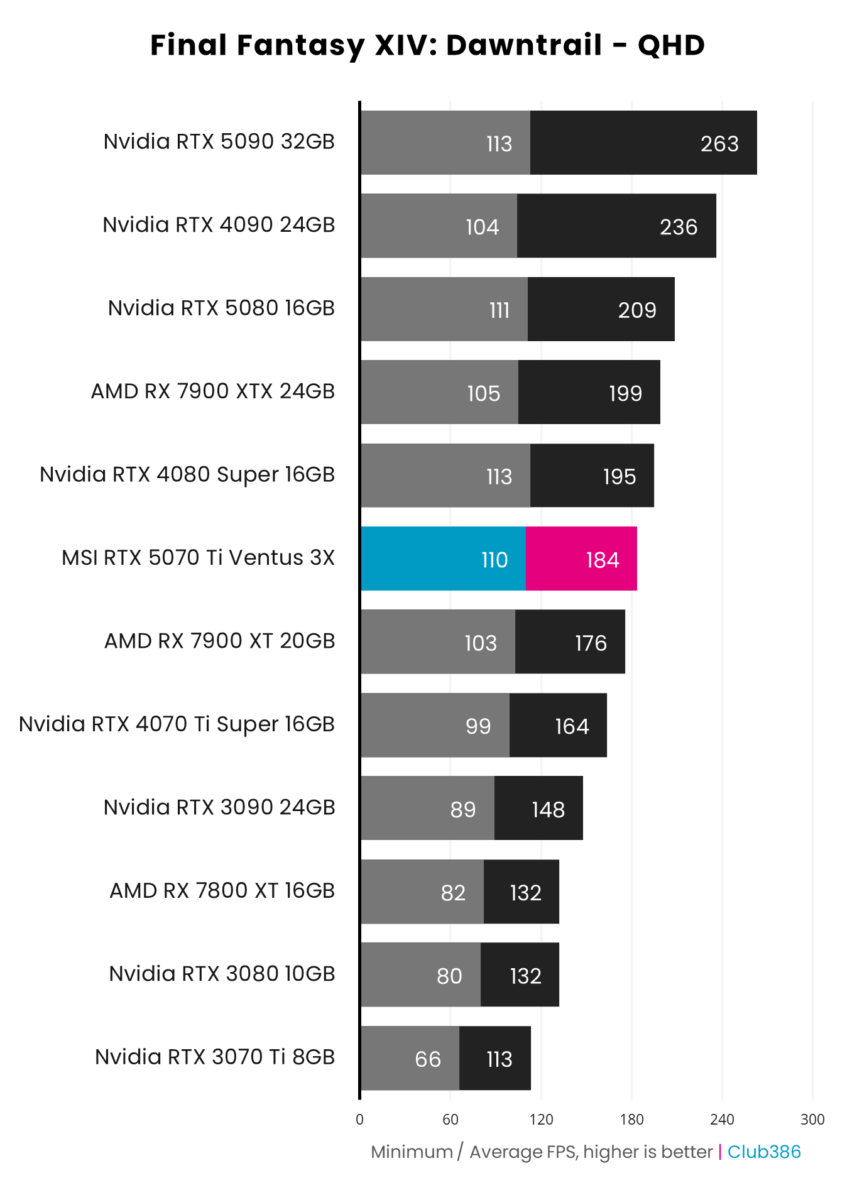
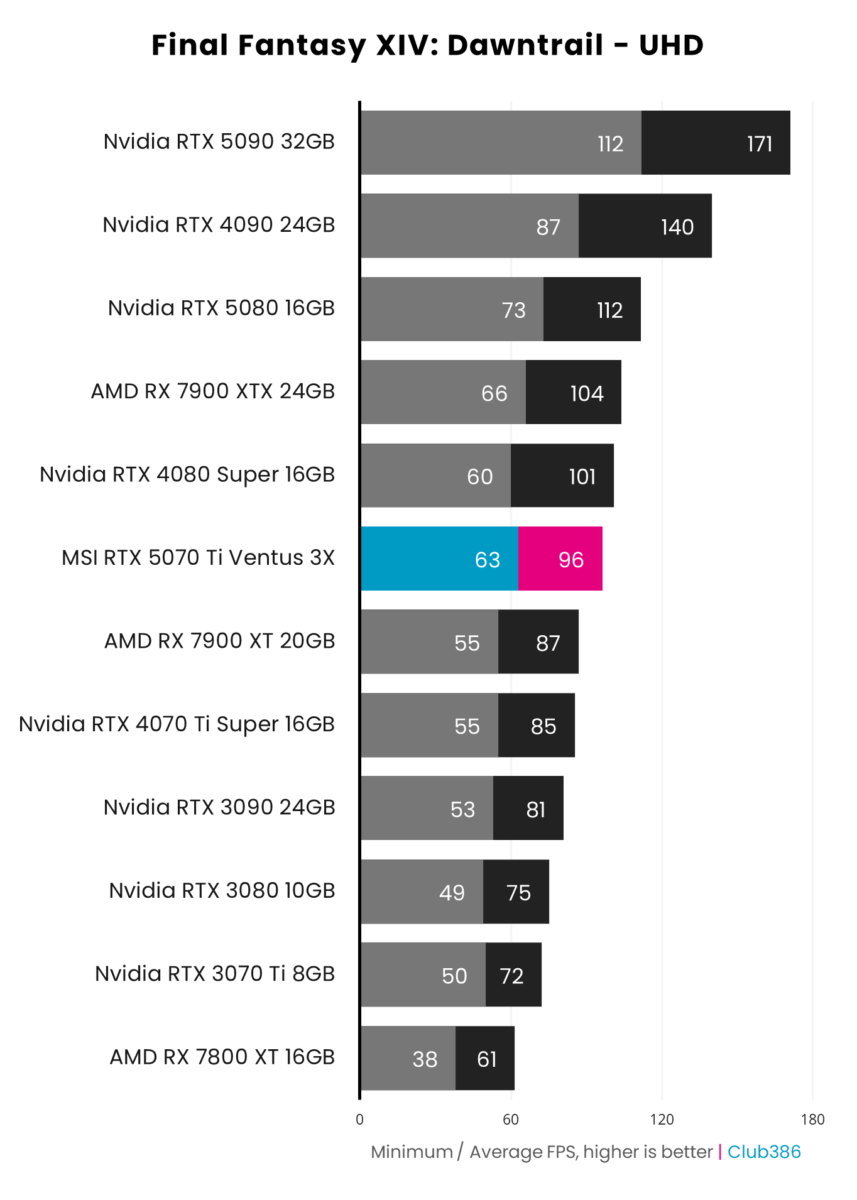
Final Fantasy XIV: Dawntrail is a fairly forgiving game with most modern graphics cards, meaning it’s not surprusing our middle-class model maxes most monitor refresh rates at FHD. Crank things up to 4K and you’ll only just miss out on triple-figure frames, which is nothing to scoff at.
At up to 13% faster than RTX 4070 Ti Super, it’s not the most economical upgrade but it’s the easy pick for QHD gamers jumping from something less performant, even beating RTX 3090 by 24%.
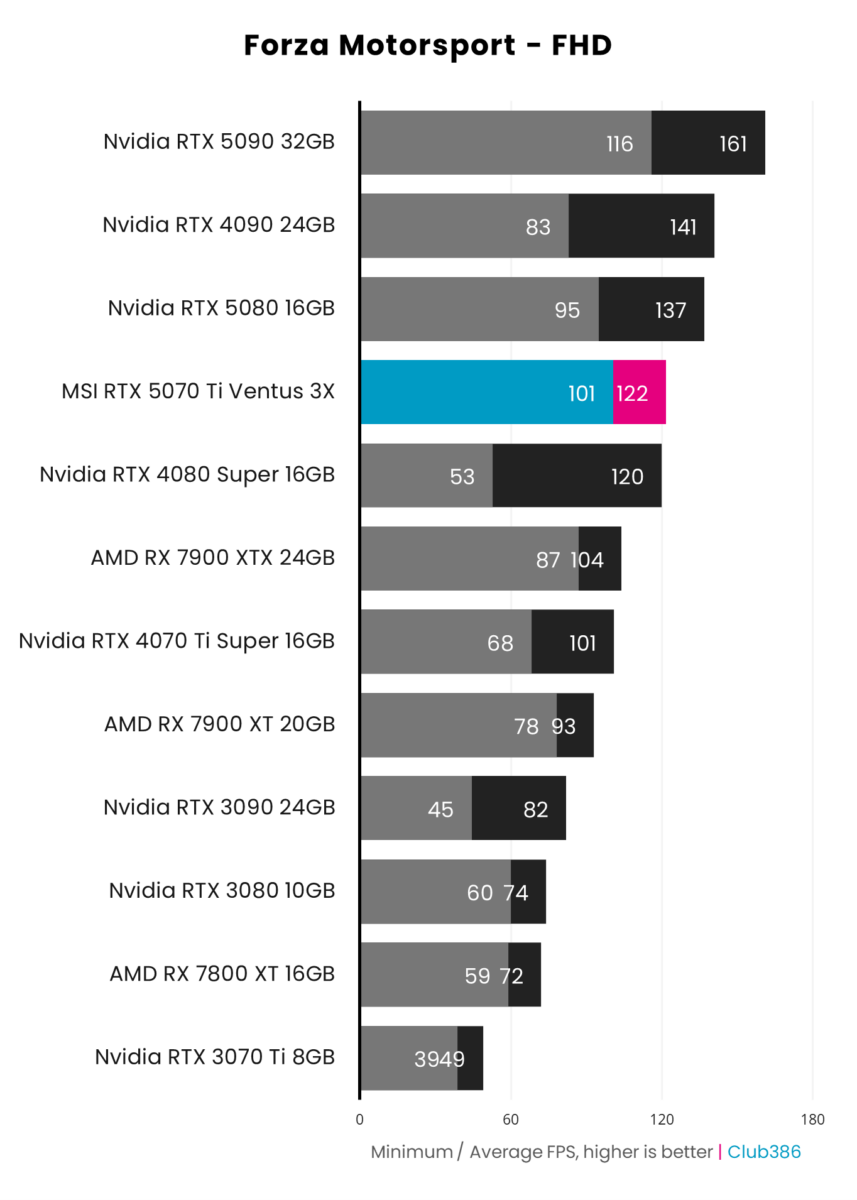
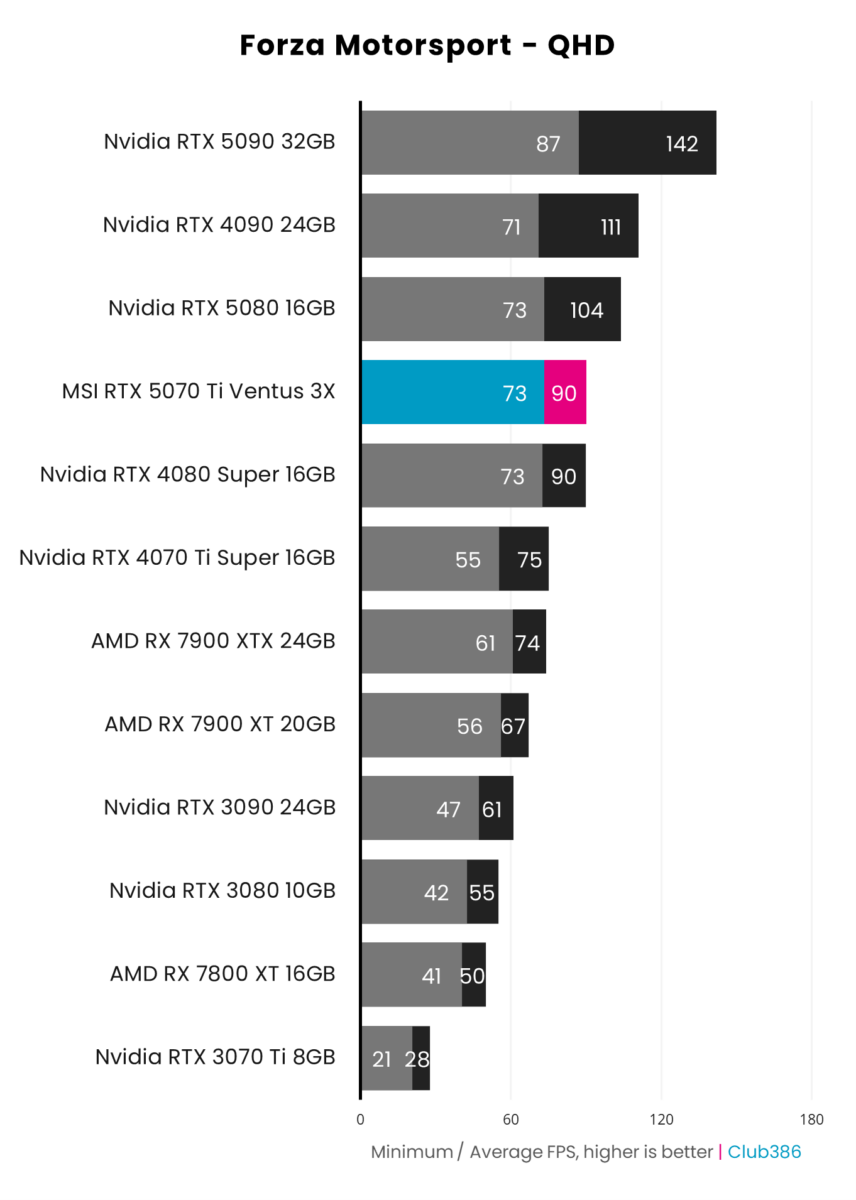
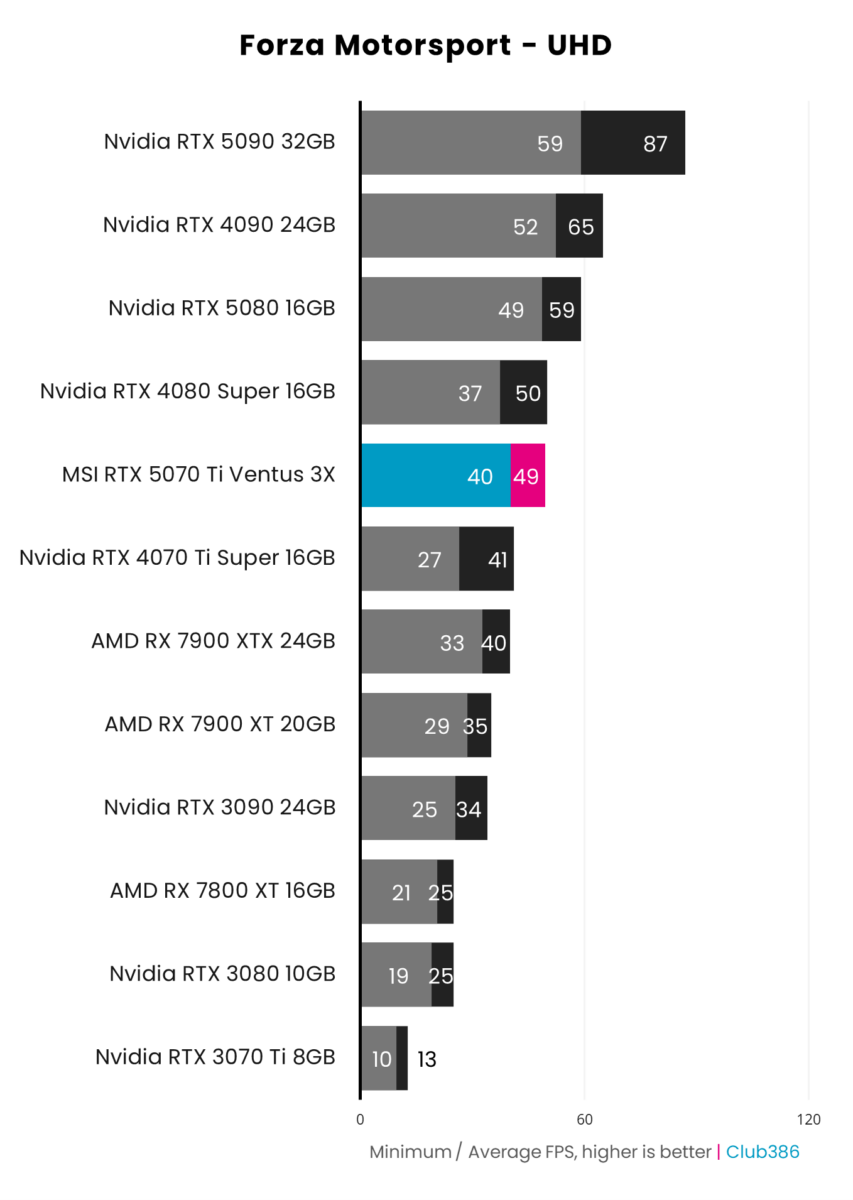
Conversely, Forza Motorsport is a ruthless benchmark that tests the mettle of even the best graphics cards out there. RTX 5070 Ti proves itself worthy at FHD and QHD, going toe-to-toe with the previous 80-class fighter and leaving former 70-class contenders in the rear-view mirror.
Expectedly, it falls short in the 4K battleground. Granted, we’re grading on a curve here as just two GPUs pass the 60fps bar we set as PC gamers, but it notably provides a lesser native experience at 49fps. If ever a game needed Multi Frame Generation.
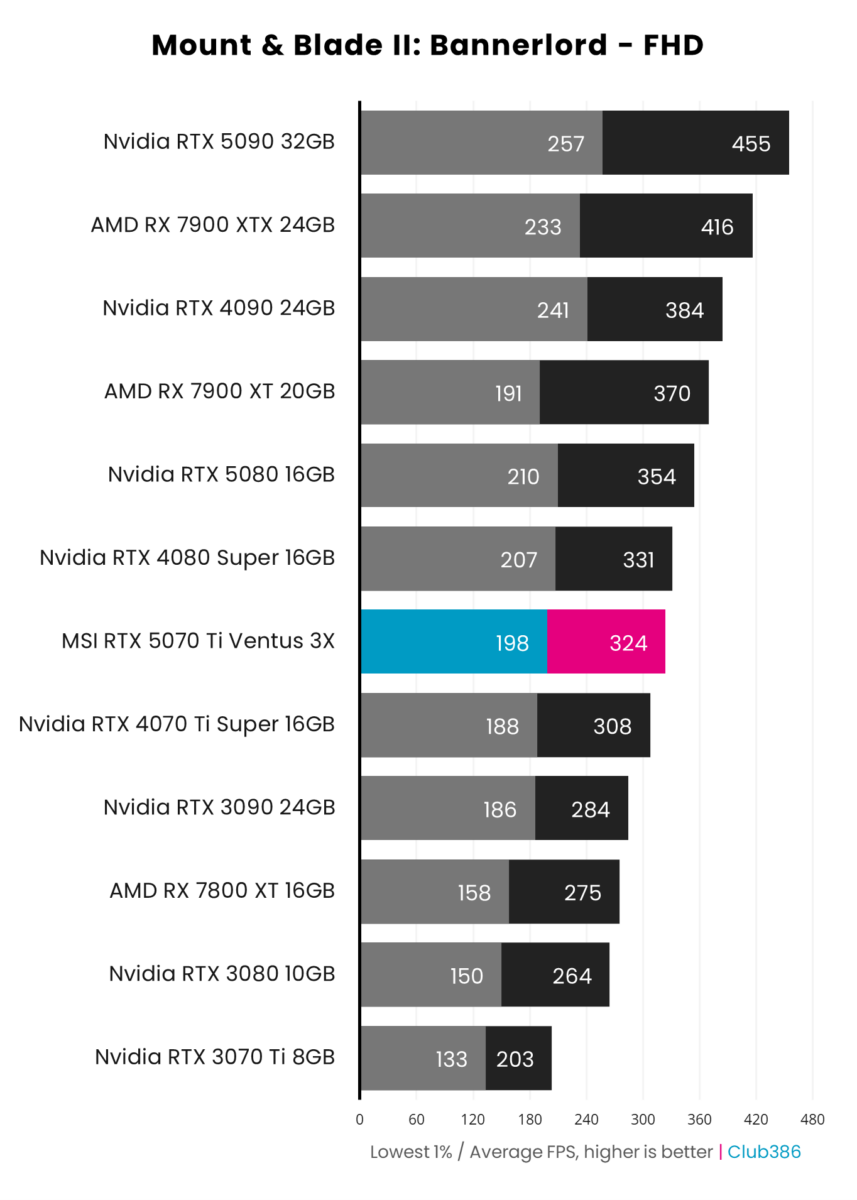
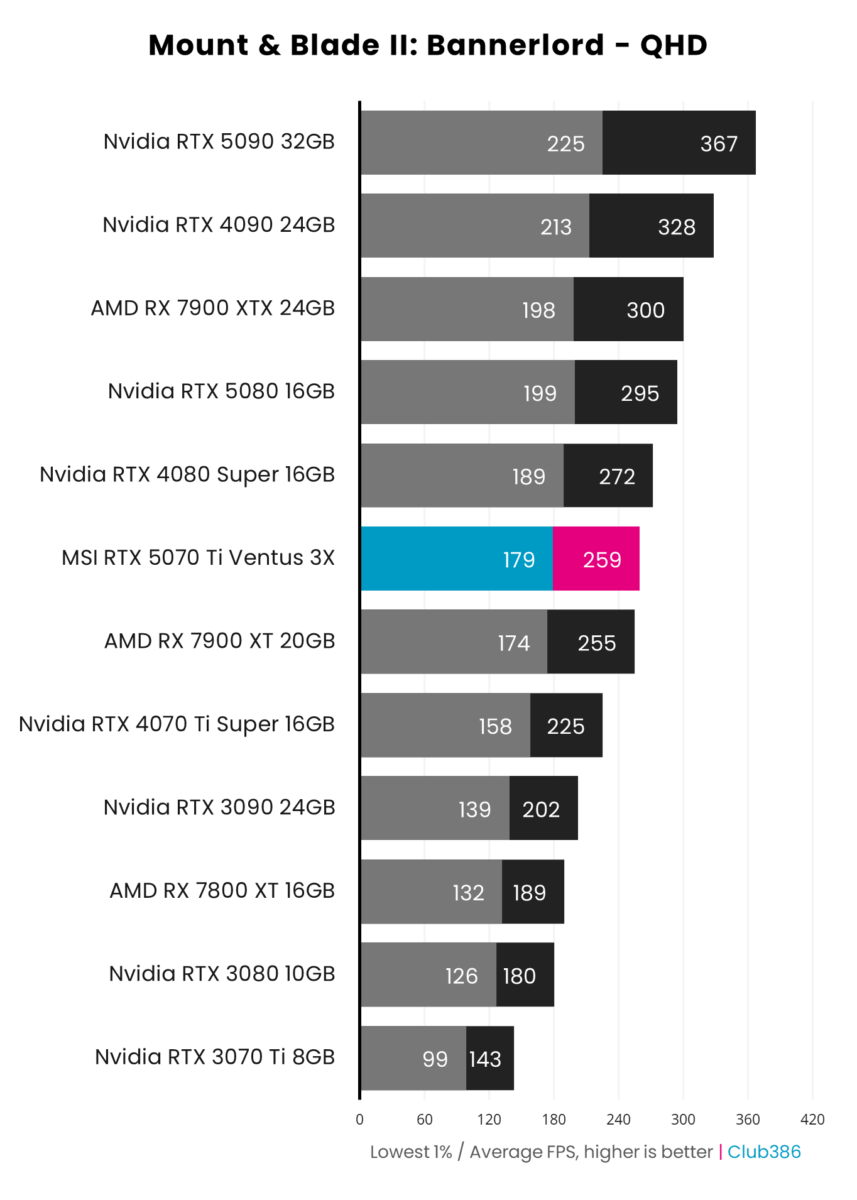
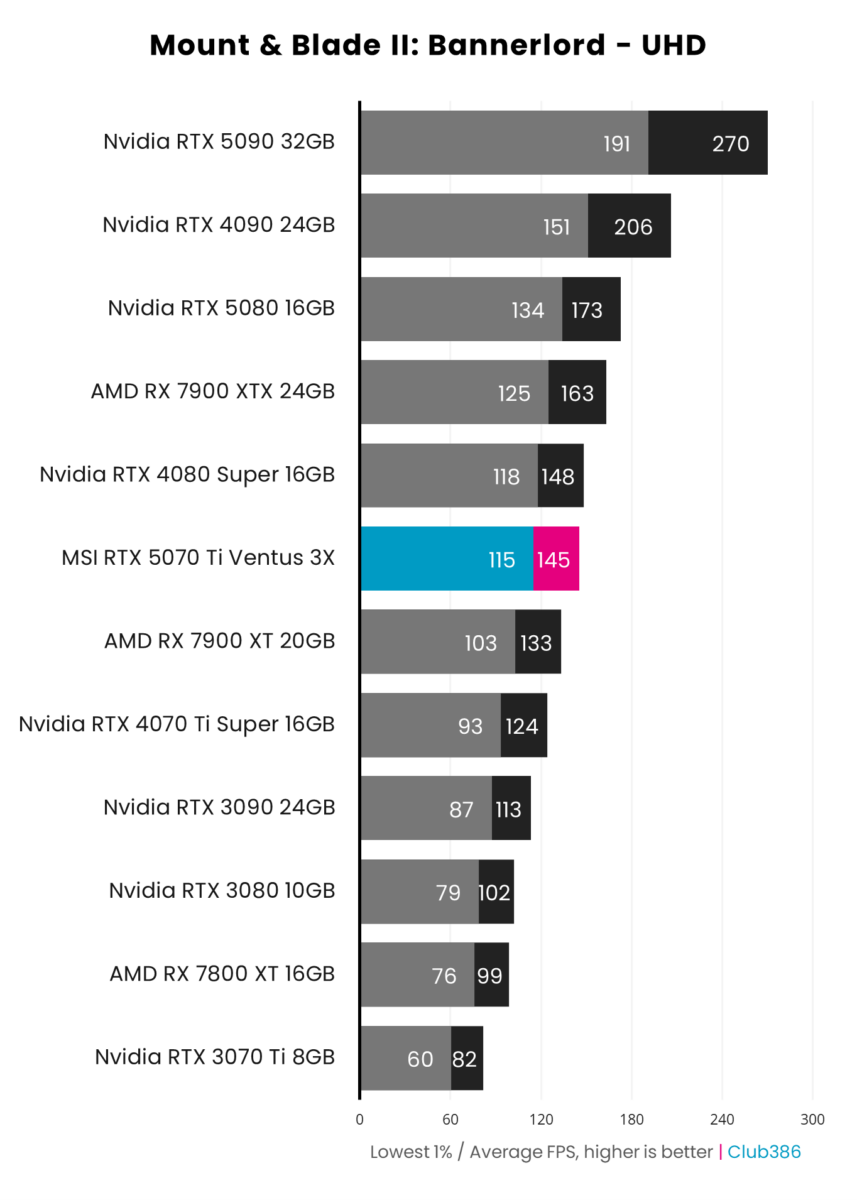
MSI GeForce RTX 5070 Ti maintains its place in Mount & Blade II: Bannerlord, snug between the two RTX 40 Series Super cards. That said, it flips the script with more a middling 5% FHD improvement and a comparatively impressive 17% UHD gain over its predecessor. Tapping out at 145fps, there’s no complaining about smooth visuals in this strategy game.
Users rocking a 4070 Ti should feel no urgency to rush out on upgrade. Those armed with RTX 3070 Ti, however, can look forward to up to an 80% bump in framerate at higher resolutions, owing in no small part to the doubling of video memory.
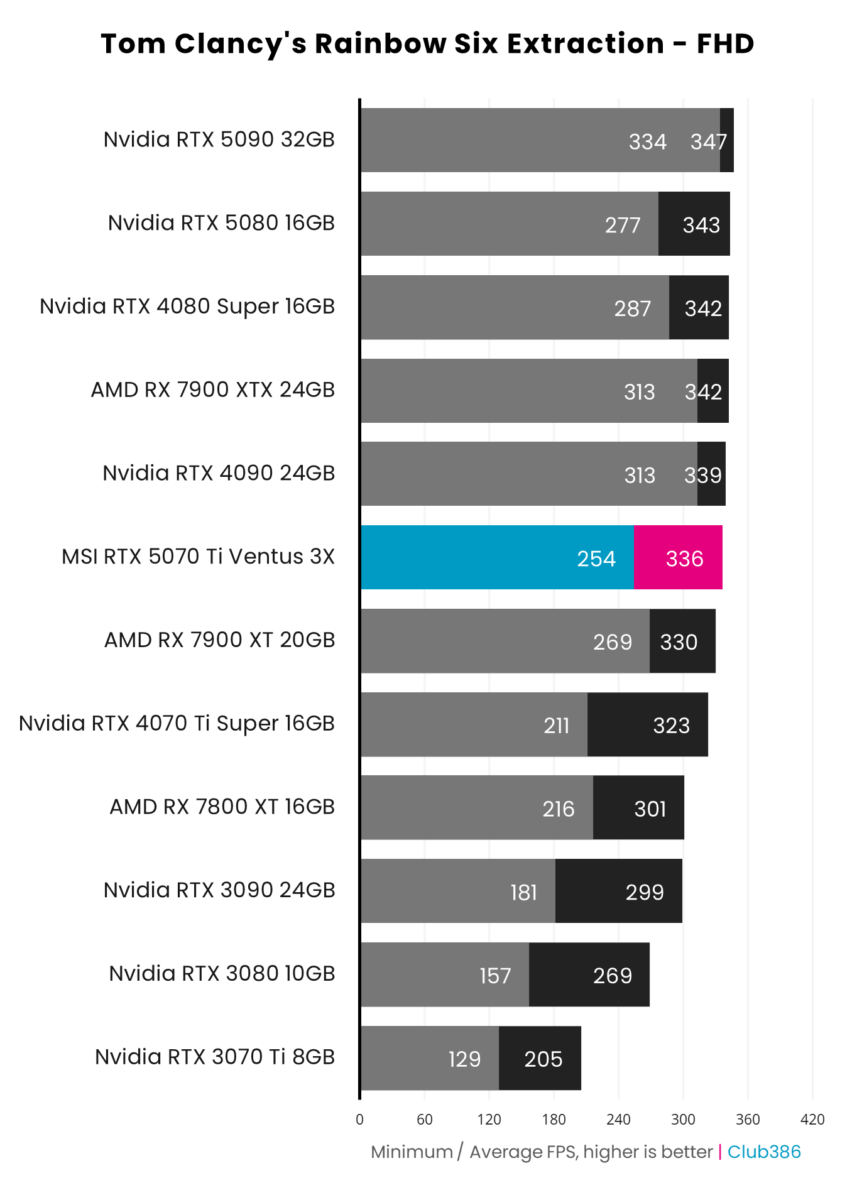
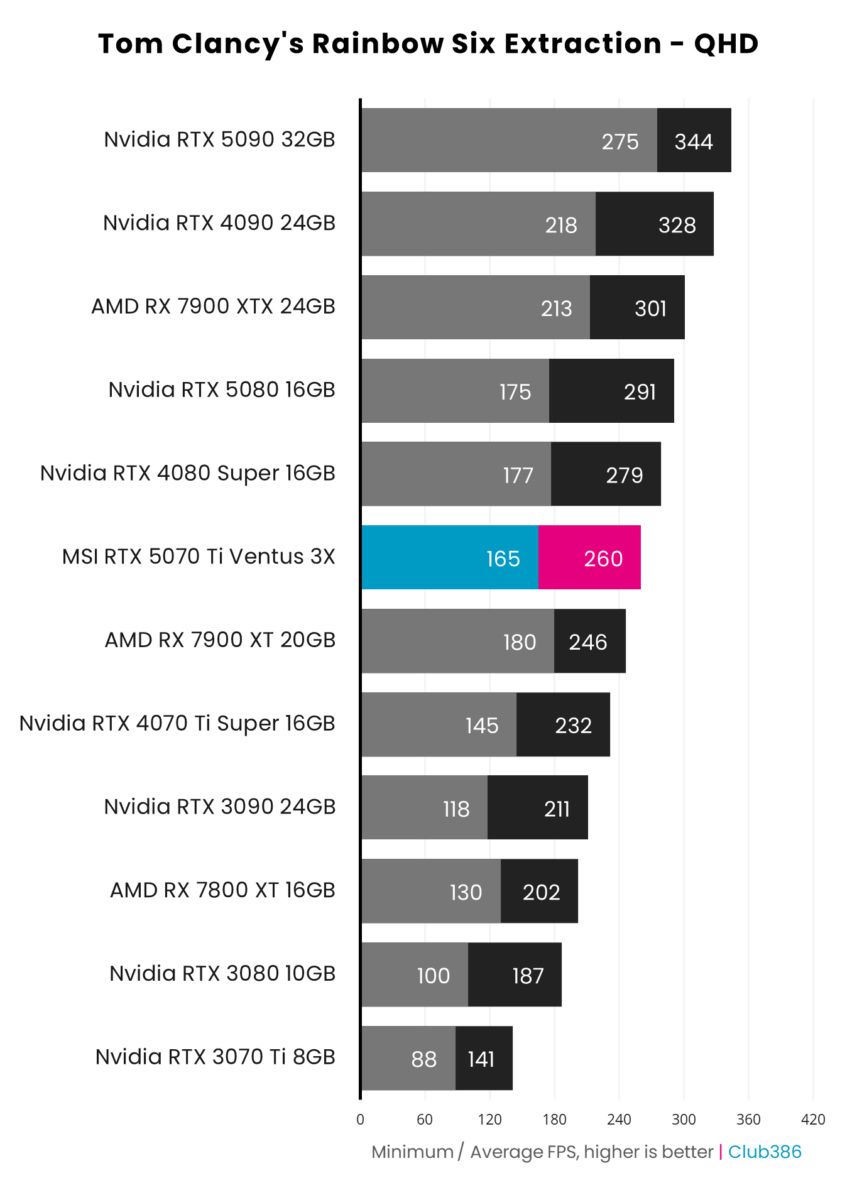
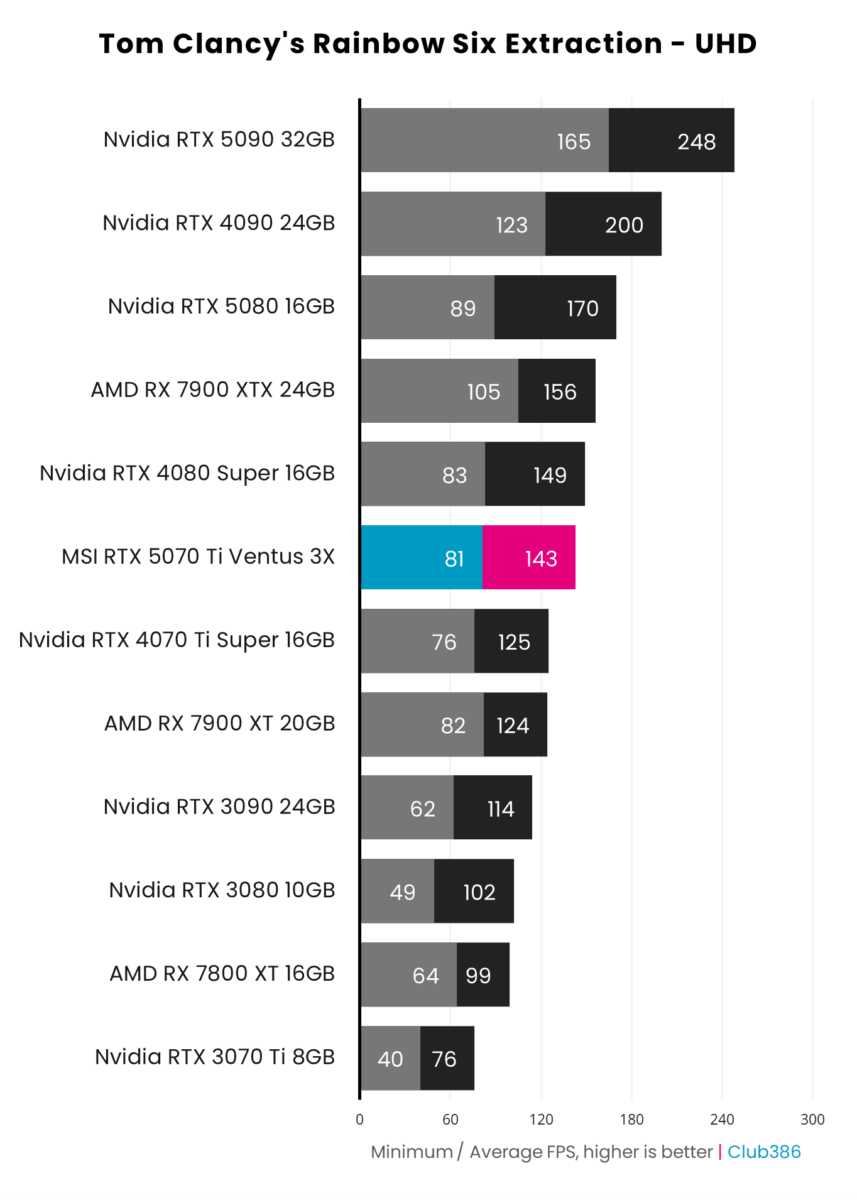
The same advice rings true here. 4070 Ti owners can stay put. You really need to be sporting 3070 Ti or older for Nvidia’s latest mid-range offering to be an attractive destination.
| Average increase or decrease at 4K | |
|---|---|
| RTX 5090 to RTX 5070 Ti | -43% |
| RTX 4090 to RTX 5070 Ti | -28% |
| RTX 5080 to RTX 5070 Ti | -15% |
| RTX 4080 Super to RTX 5070 Ti | -3% |
| RX 7900 XTX to RTX 5070 Ti | -2% |
| RX 7900 XT to RTX 5070 Ti | +13% |
| RTX 4070 Ti Super to RTX 5070 Ti | +15% |
| RTX 3090 to RTX 5070 Ti | +29% |
| RTX 3080 to RTX 5070 Ti | +40% |
| RX 7800 XT to RTX 5070 Ti | +56% |
| RTX 3070 Ti to RTX 5070 Ti | +114% |
MSI GeForce RTX 5070 Ti straddles the line between a QHD and UHD graphics card. With so many favourable 4K showings, I opted for the higher resolution as a comparative benchmark.
The numbers aren’t spellbinding on their own, offering a 16% uplift over RTX 4070 Ti Super in rasterised performance, but the story doesn’t end there. Factoring in a slimmer price tag, the card is a convincing upgrade over Ampere should you be able to get your hands on one. And this is with an increasingly familiar trick left up its sleeve: Multi Frame Generation (MFG).
Frame Generation
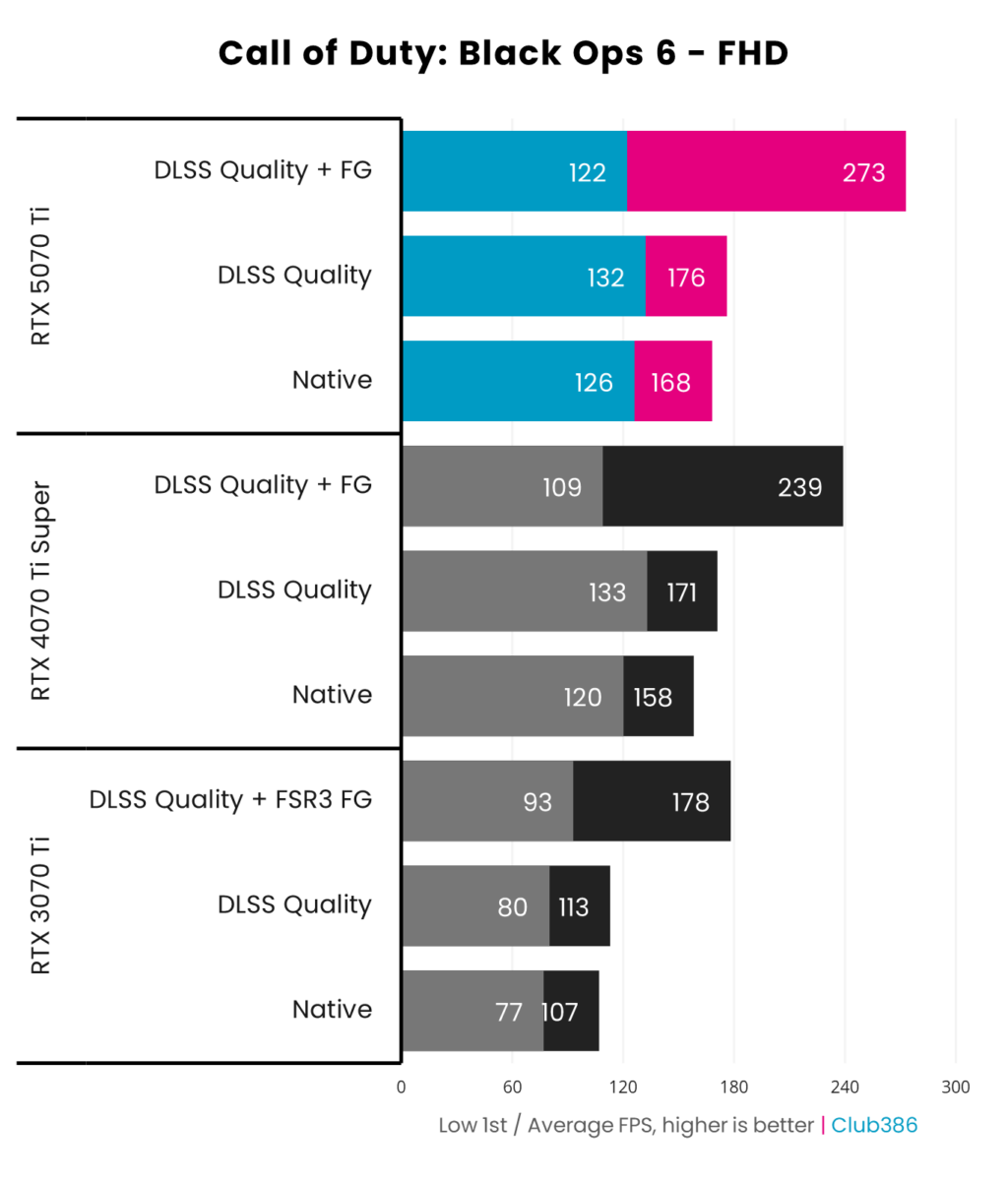
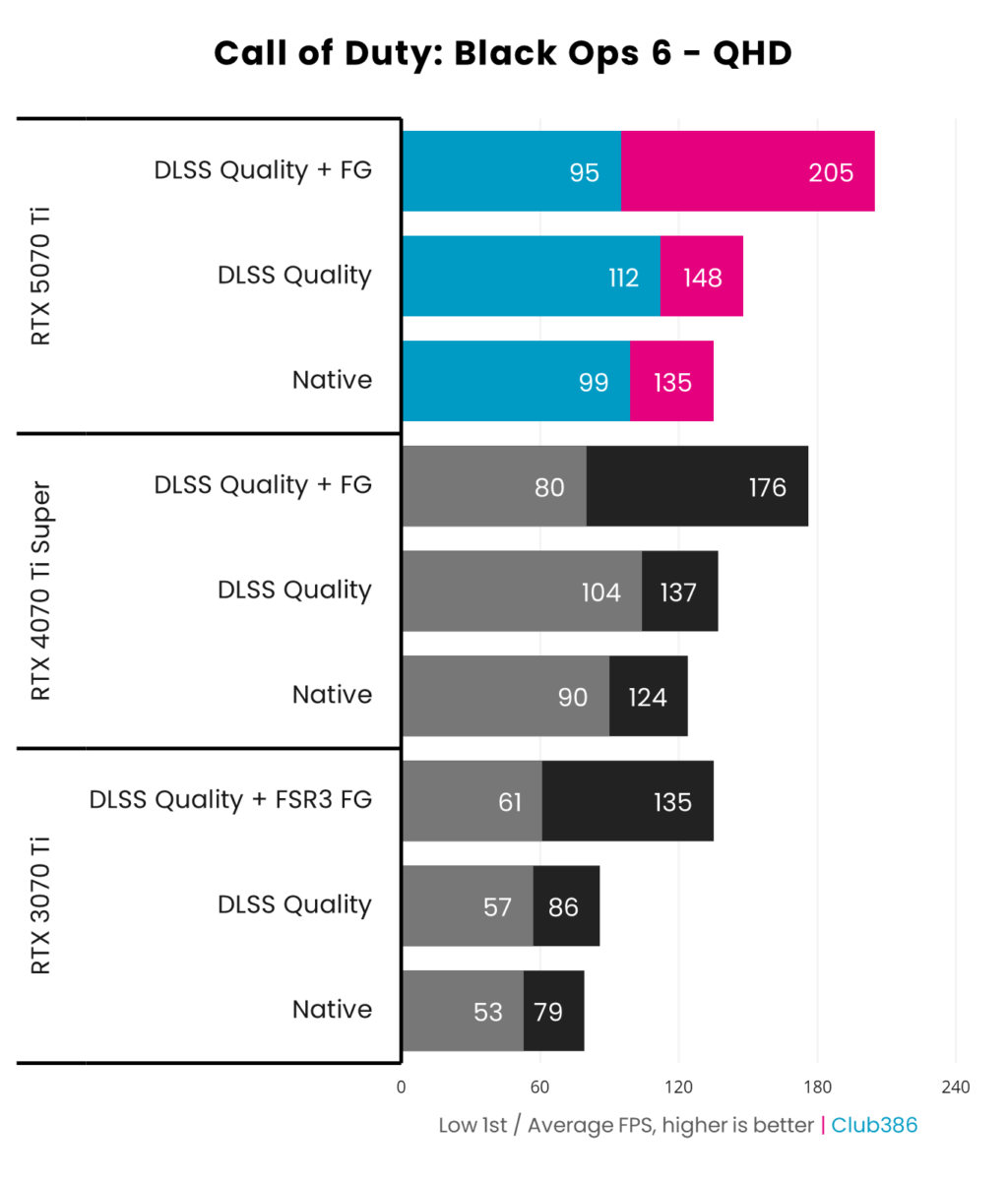
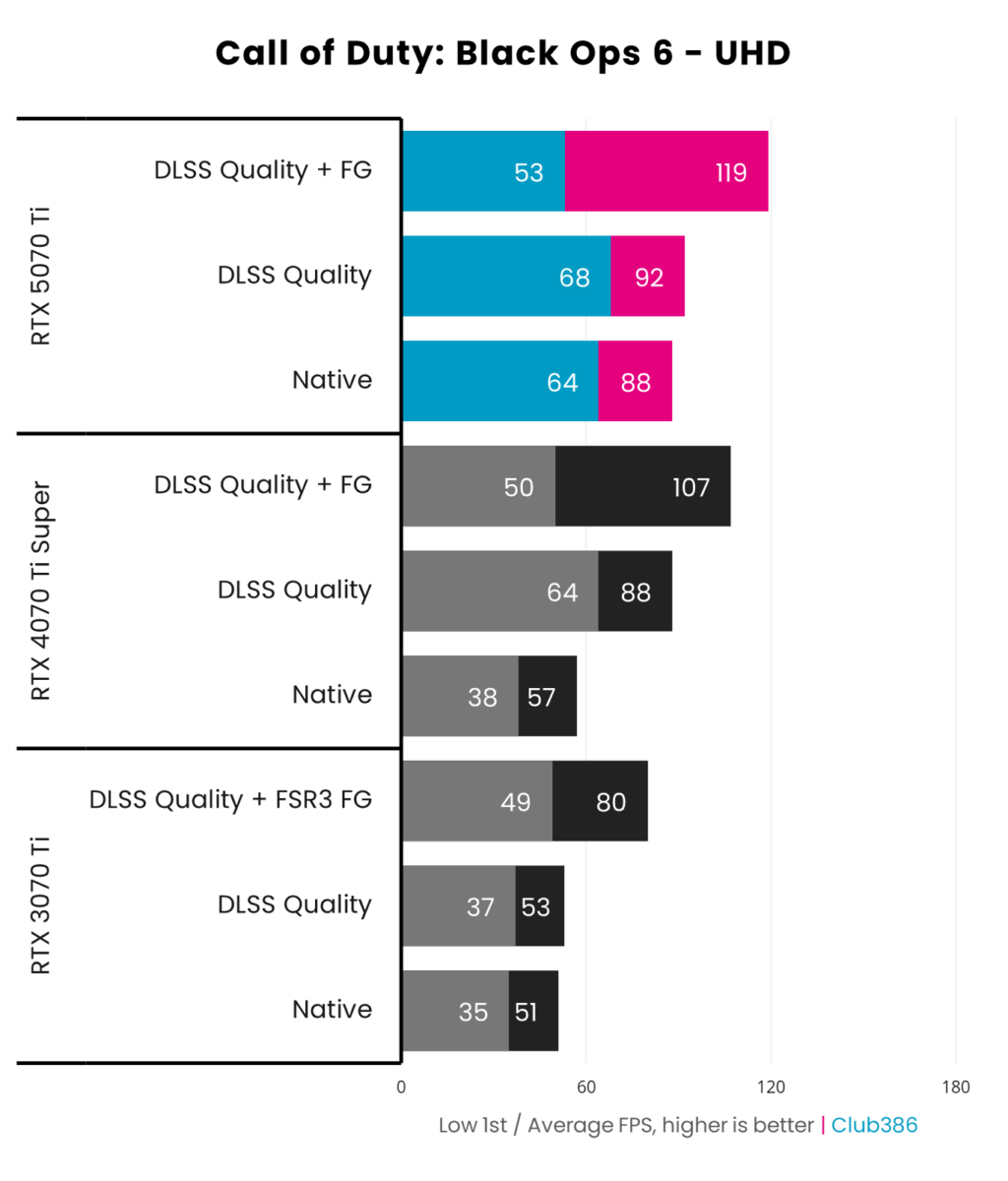
The latest 70-class card barely moves the needle on native performance when running Call of Duty: Black Ops 6 at lower resolutions but offers a more definitive shift at UHD. It’s only when you tack on Nvidia’s Frame Generation, slipping an extra AI-generated frame in between each rasterised, that Blackwell comes to life. DLSS 4 treats the latest architecture well, adding up to 34fps on top of anything RTX 40 Series can muster.
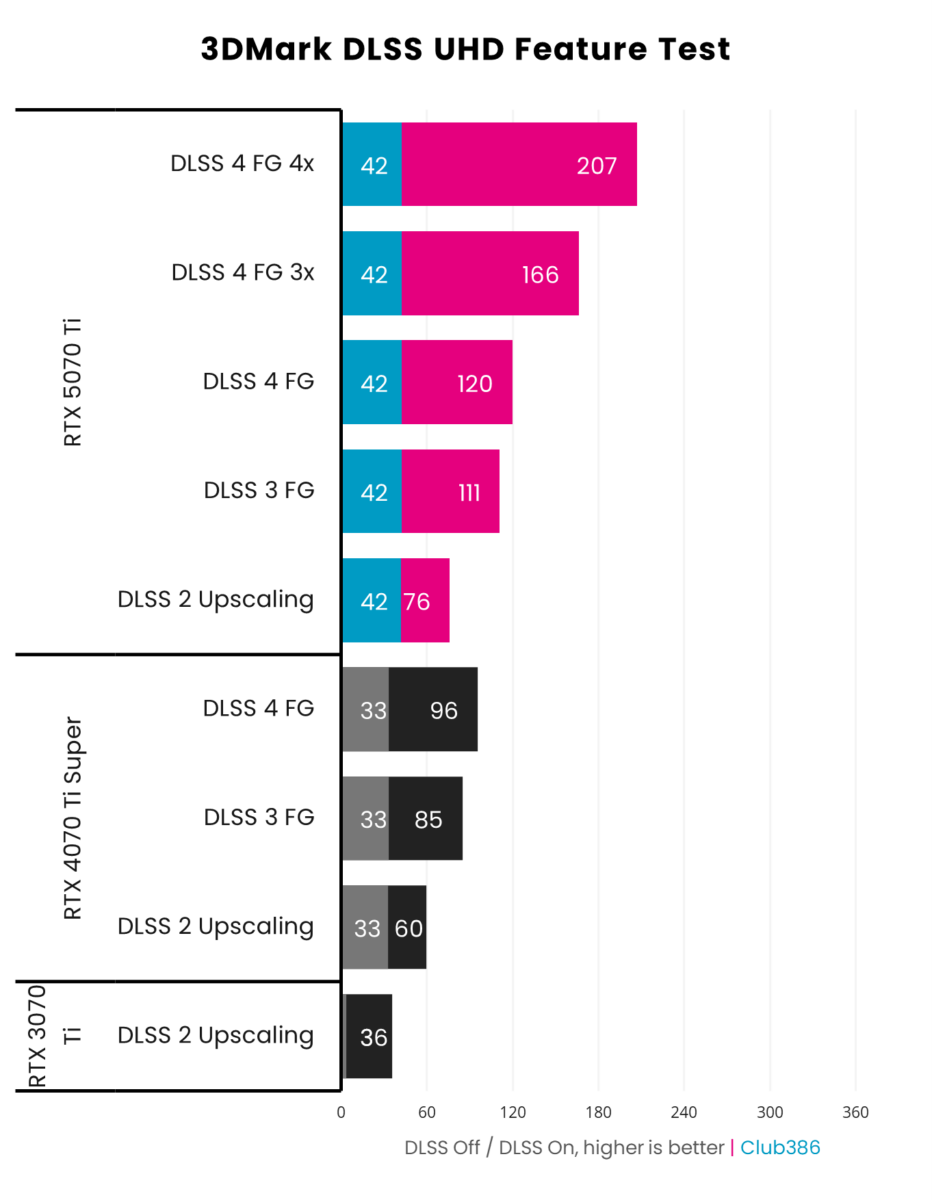
It’s already a spectacle to see just how far DLSS has come over the years and how the latest graphics cards handle the upscaling tech, but the beauty of Blackwell is that the ceiling doesn’t stop there. Nvidia grants the ability to add a second or even third frame into the mix with Multi Frame Generation.
On top of RTX 5070 Ti’s already substantial 25% domination in 3DMark DLSS tests, it increases this lead to 73% with x3 and completely laps its predecessor with x4. It’s worth noting that this is entirely support-dependent, relying on game developers to implement the tech. It’s tough to recommend a graphics card solely on the merit of MFG, but it sure does help.
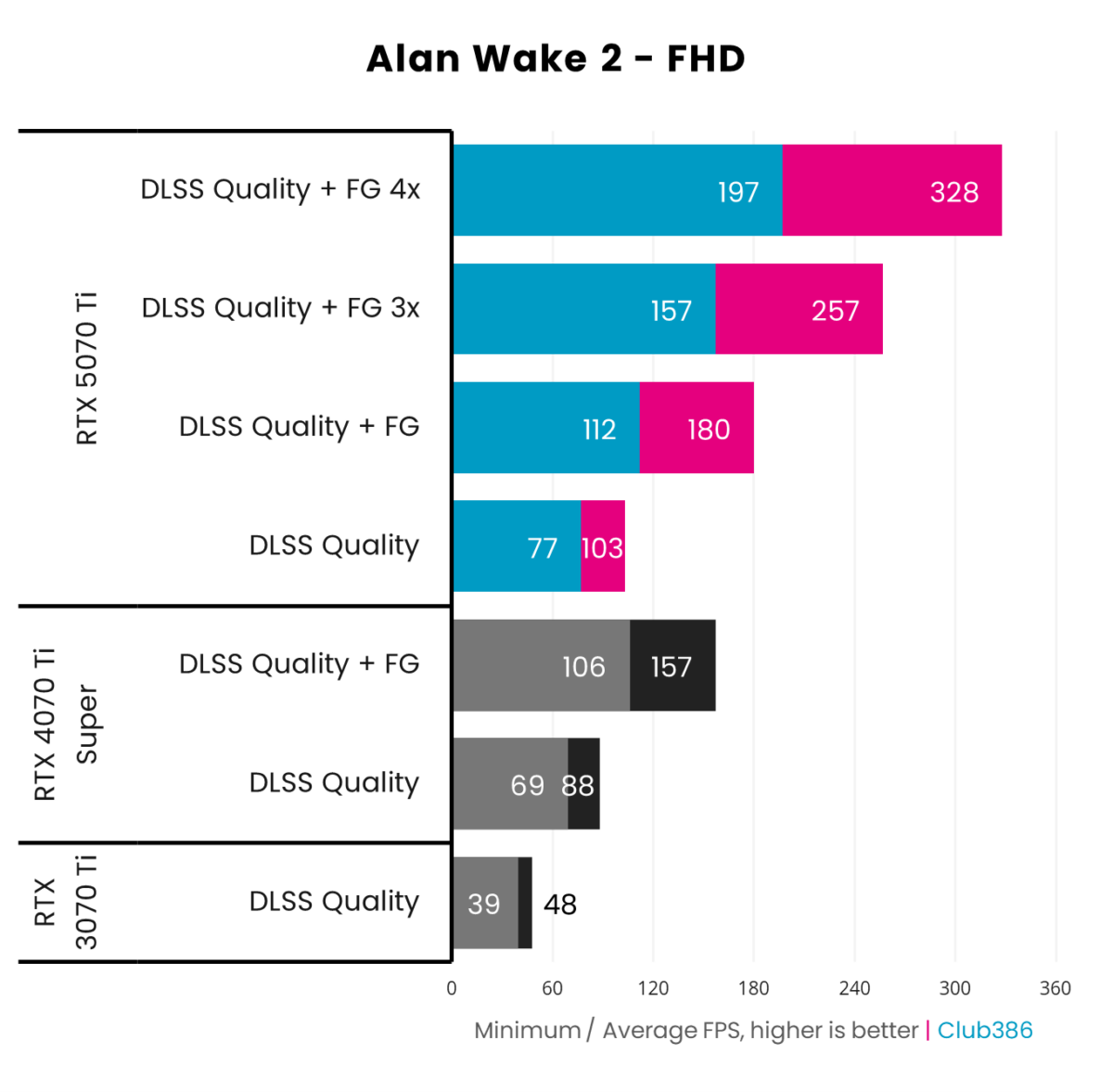
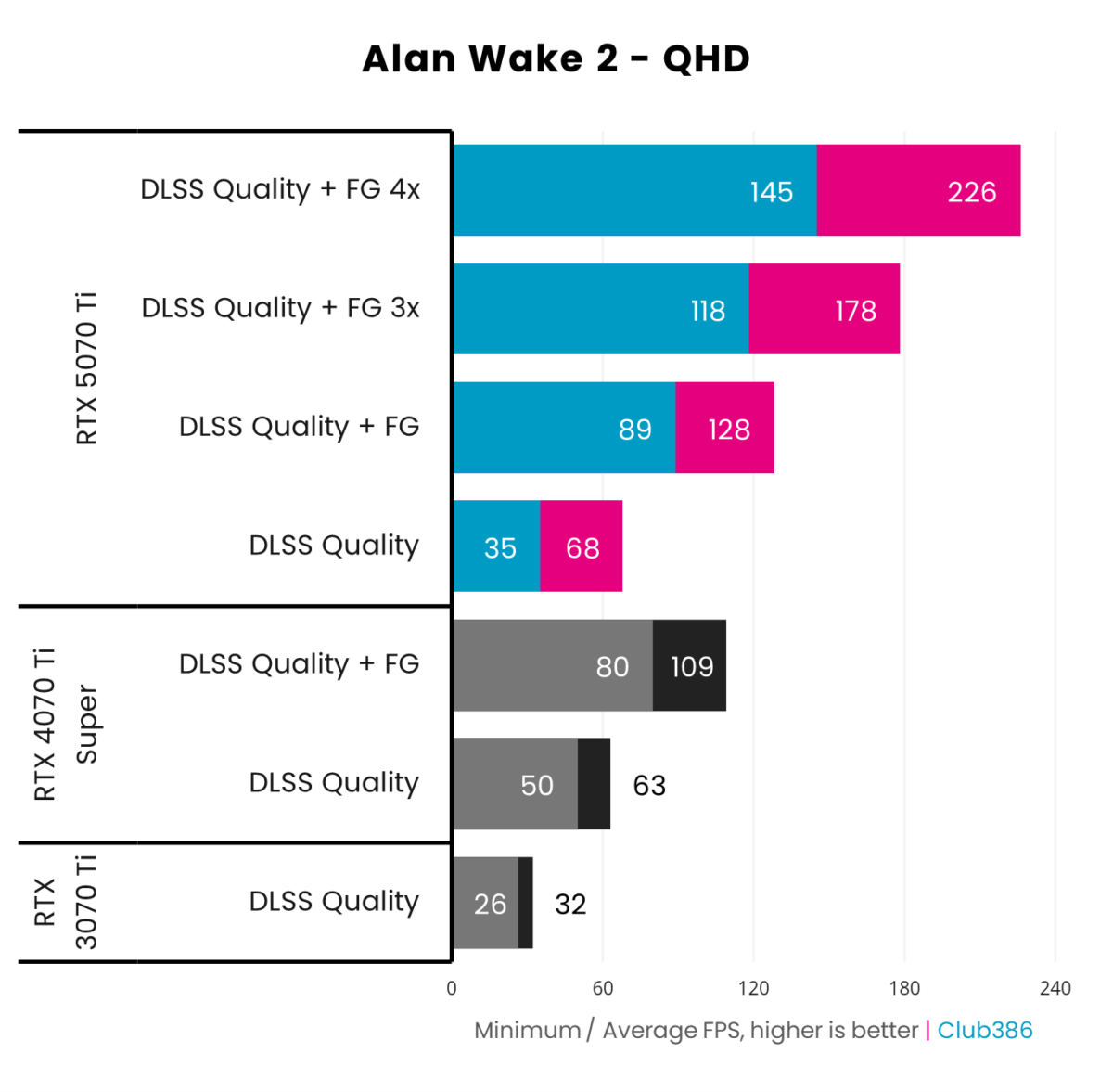
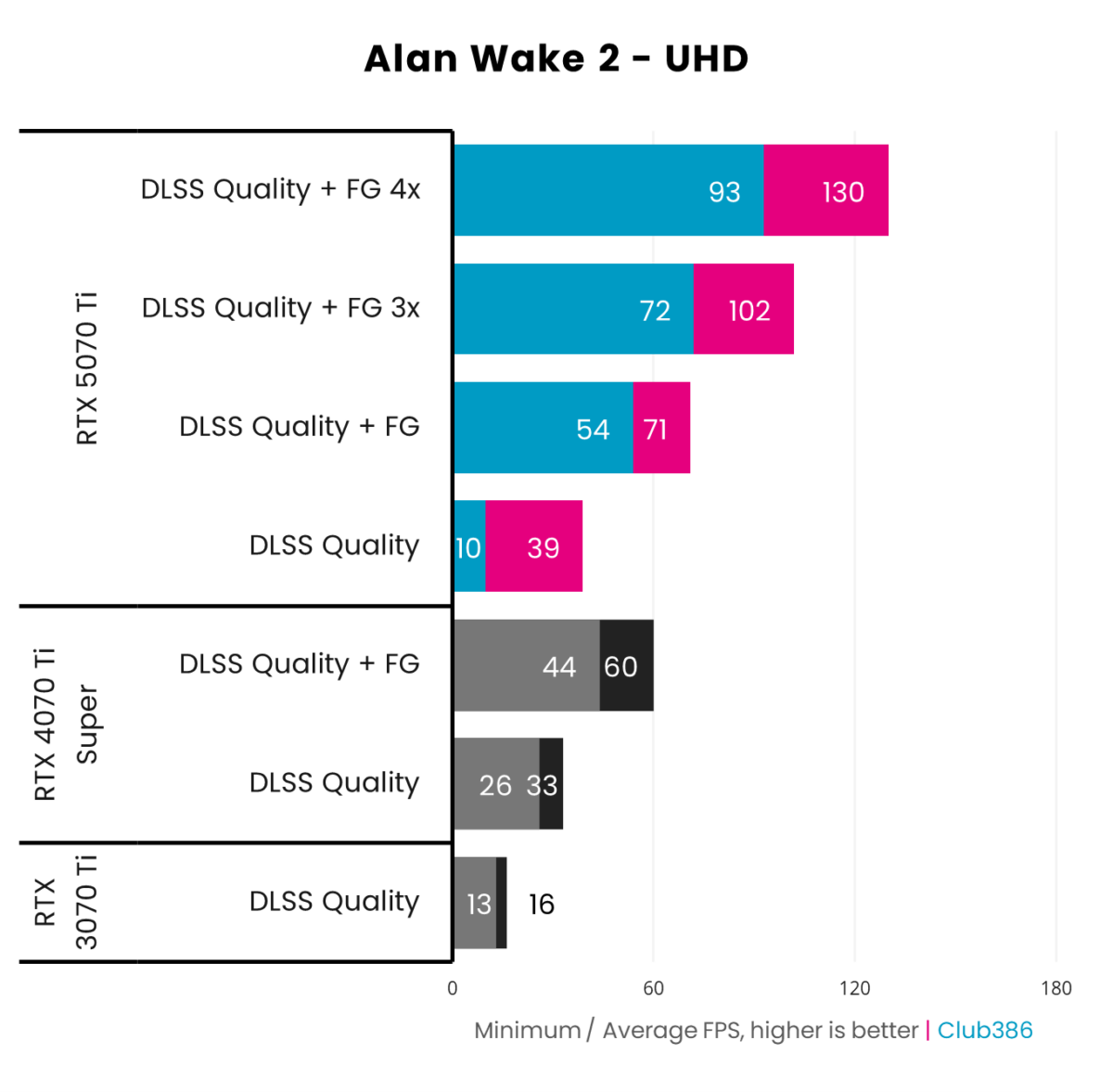
Driving home just how taxing Alan Wake 2 is, you can’t run the game without some form of upscaler. Add path tracing into the mix, and even the beefiest GPUs start working up a sweat. All of this underscores just how strong Multi Frame Generation is, not only doubling frame rate, but going from merely playable to buttery smooth.
As impressive as FHD numbers are, I’d avoid the resolution as it’s prone to the same kinds of artefacting that’s plagued DLSS since its inception. Move to QHD and the detail improves substantially to the point it’s much more difficult to tell the difference between native and upscaled. Neon signs atmospherically glow above you while trees spookly blow in the wind. It’s all a sight to behold.
| Native Latency | FG Latency | FG 3x Latency | FG 4x Latency | |
|---|---|---|---|---|
| 5070 Ti @ UHD | 70ms | 82.4ms | 85.4ms | 92.2ms |
| 5070 Ti @ QHD | 40.2ms | 47.8ms | 51.9ms | 55.4ms |
| 5070 Ti @ FHD | 30.8ms | 37.7ms | 39.7ms | 42.8ms |
The trade-off is latency. While input lag falls as native frame rates increase, the opposite is true when using Frame Generation. Not only can the boosting technique not go any lower than the latency of the base frame rate it’s working off, working its magic adds milliseconds due to extra processes in the pipeline.
Nvidia recommends a base frame rate of 60fps to keep input lag low when using Multi Frame Generation, and it’s easy to see why. Our RTX 5090 hits just that at UHD and sees less than 13ms added in Alan Wake 2. RTX 5070 Ti begins its 4K journey at 39fps and 70ms of latency, but ends up with a whopping 92.2ms by the time 130fps shows on-screen. Nvidia Reflex curbs it enough that I’d deem it worth the sacrifice in immersive games in spite of the recommended 60fps floor, but wouldn’t risk it in a competitive environment as it could introduce a feeling of sluggishness.
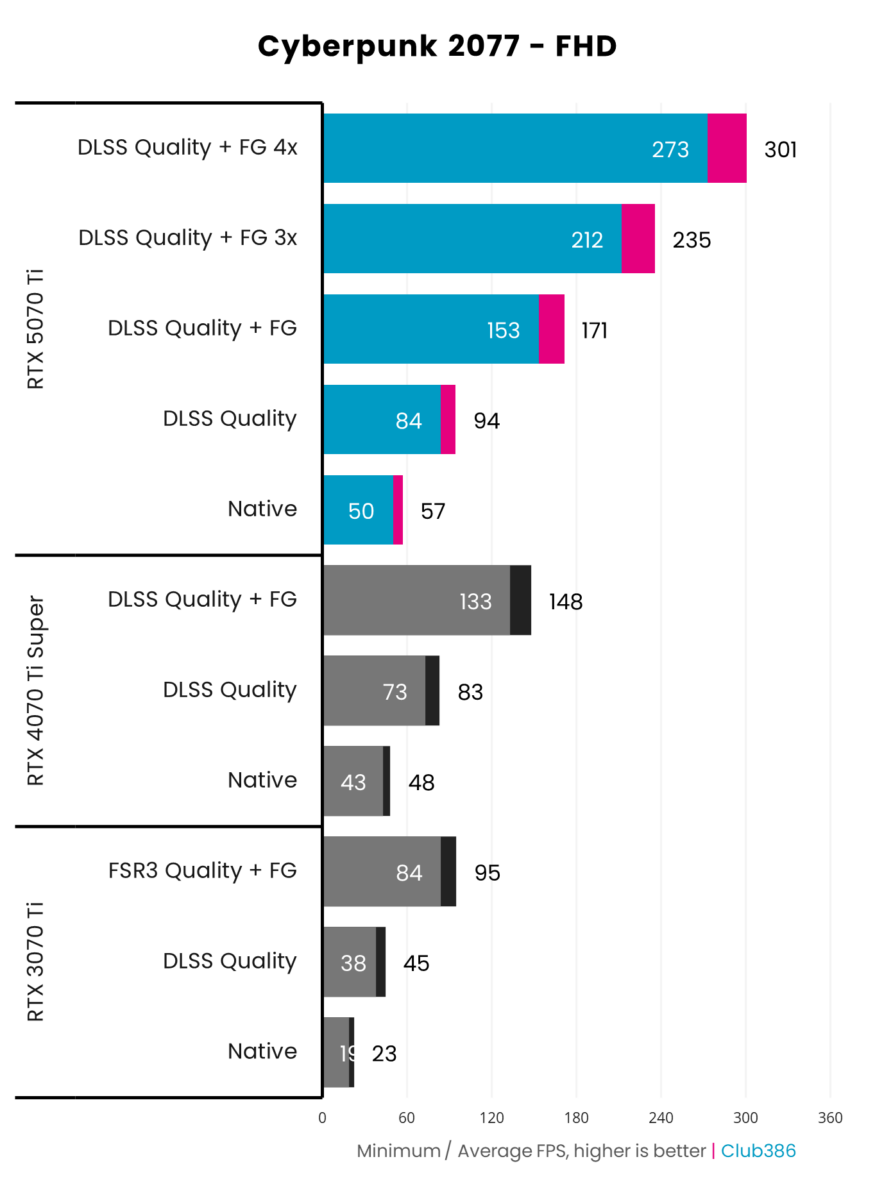
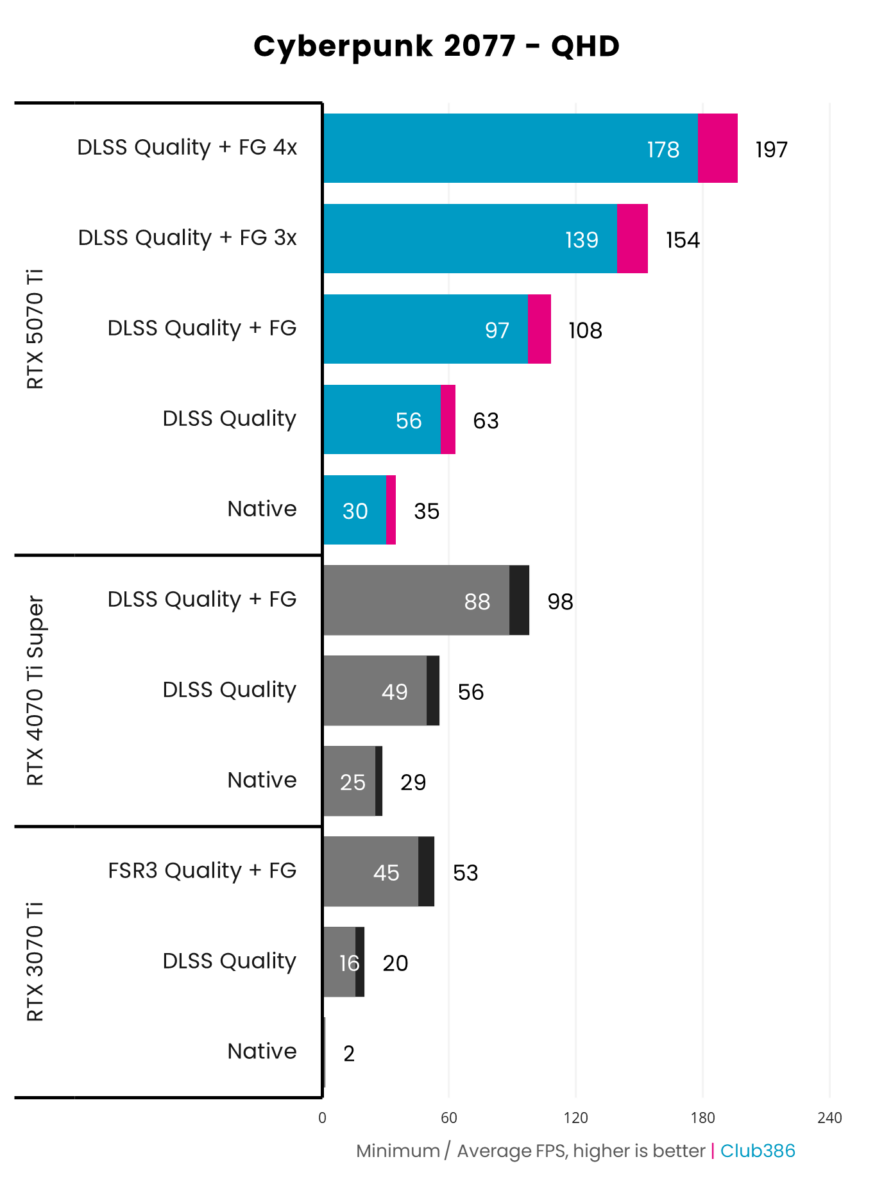
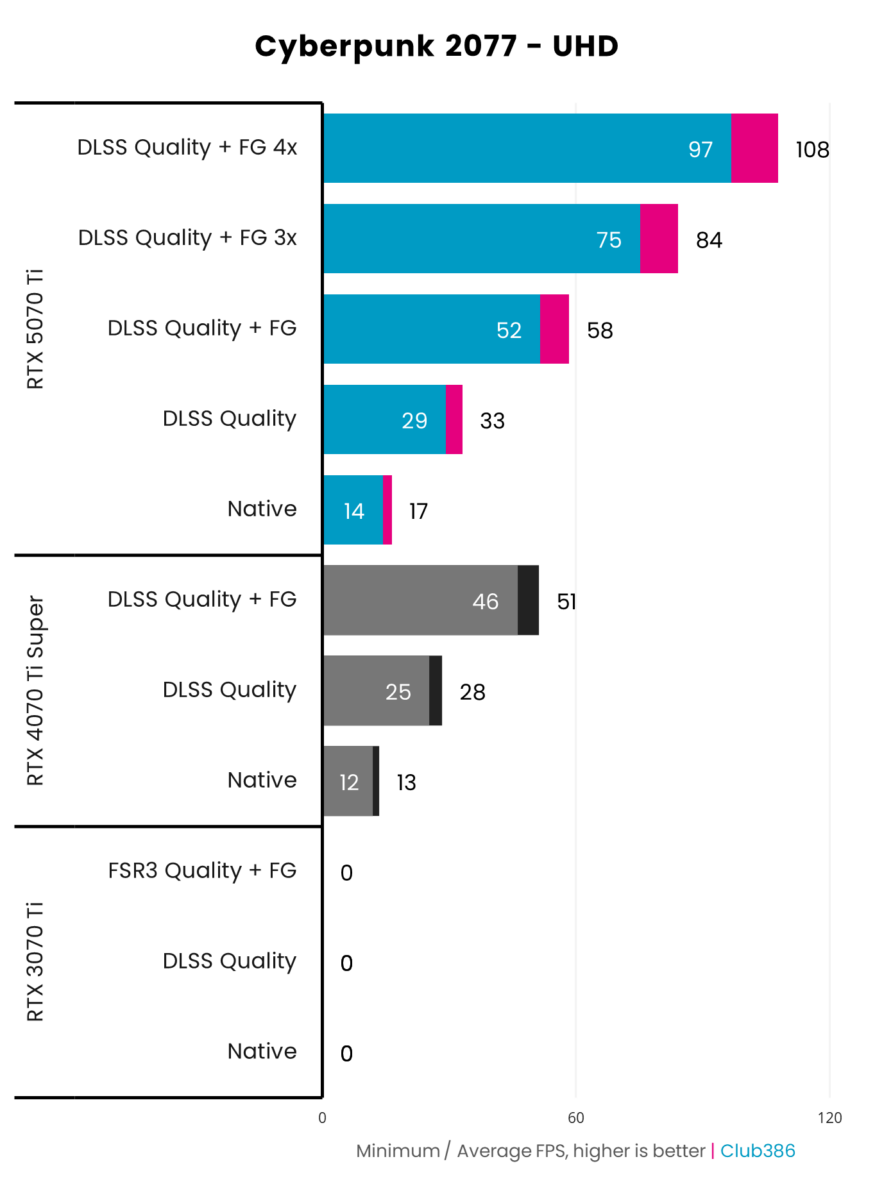
Cyberpunk 2077 is notoriously overwhelming with its monstrous ray tracing presets, to the point that poor old RTX 3070 Ti couldn’t even run the test at higher resolutions. As competent as RTX 4070 Ti Super is, even the former midrange prince can’t tame the RPG at UHD.
GeForce RTX 5070 Ti almost meets the bar, but it’s not until Multi Frame Generation comes into the picture that it races across the line into a category of its own. At full pelt, you’ll get triple-digit frame rates no matter the resolution, each doubling standard Frame Gen’s capabilities.
With 75 supported titles and counting, MFG is off to a grand start but still at the whim of game developers investing the time and energy into the feature. If RTX 50 Series adoption remains slow due to stock contraints, part of me worries that MFG implementation will similarly fall behind, but this is all conjecture and only time will tell.
Conclusion
In a nutshell, MSI GeForce RTX 5070 Ti Ventus 3X gives me deja vu, following the same trends as RTX 5080. It’s a superb graphics card that’s mindful of the limited space inside your PC, best suited to gamers and content creators who dabble in AI. Should it remain available and maintain its $749 MSRP, it could very well be the perfect upgrade for users still clinging to 30- or 20-Series cards.
Since it suffers from the same modest rasterisation gains as the rest of the Blackwell lineup, it’s far less appealing to RTX 40 Series users, but there’s still merit to its Multi Frame Generation approach. Intelligent neural networks blow the roof off everything that came before, opening up a whole new world of possibilities for the average gamer – provided your chosen game supports the feature.

